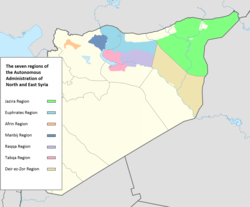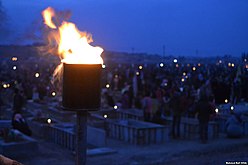Autonomous Administration of North and East Syria
Autonomous Administration of North and East Syria
| |
|---|---|
| Status | De factoautonomous regionofSyria |
| Capital | Ayn Issa[1][2] 36°23′7″N38°51′34″E/ 36.38528°N 38.85944°E |
| Largest city | Raqqa |
| Official languages | See languages
All regions: In the Jazira Region: In the Manbij Region: |
| Government | Federatedsemi-direct democracy |
| Îlham Ehmed[3]
Mansur Selum[4] | |
| Amina Omar Riad Darar[5] | |
| Legislature | Syrian Democratic Council |
| Autonomous region | |
• Transitional administration declared | 2013 |
• Cantons declare autonomy | January 2014 |
• Cantons declare federation | 17 March 2016 |
• New administration declared | 6 September 2018 |
| Area | |
• Total | 50,000 km2(19,000 sq mi)[6] |
| Population | |
• 2018 estimate | ≈2,000,000[7] |
| Currency | Syrian pound(SYP) |
| Time zone | UTC+2(EET) |
| Driving side | right |
| |
TheAutonomous Administration of North and East Syria(AANES), also known asRojava,[a]is ade factoautonomous regionin northeasternSyria.[13][14]It consists of self-governingsub-regionsin the areas ofAfrin,Jazira,Euphrates,Raqqa,Tabqa,Manbij,andDeir Ez-Zor.[15][16][17]The region gained its de facto autonomy in 2012 in the context of the ongoingRojava conflictand the widerSyrian civil war,in which its official military force, theSyrian Democratic Forces(SDF), has taken part.[18][19]
While entertainingsome foreign relations,the region is neither officially recognized as autonomous by the government of Syria, state or other governments institutions except for theCatalan Parliament.[20][21][22]The AANES has widespread support for its universaldemocratic,sustainable,autonomouspluralist,equal,andfeministpolicies in dialogues with otherpartiesand organizations.[23][24][25][26]Northeastern Syria ispolyethnicand home to sizeable ethnicKurdish,Arab,andAssyrianpopulations, with smaller communities of ethnicTurkmen,Armenians,Circassians,andYazidis.[27][28][29]
The supporters of the region's administration state that it is an officiallysecularpolity[30][31][32]withdirect democraticambitions based ondemocratic confederalismandlibertarian socialism[33][34]promotingdecentralization,gender equality,[35][36]environmentalsustainability,socialecology,and pluralistic tolerance forreligious,cultural, and politicaldiversity,and that these values are mirrored in itsconstitution,society, and politics, stating it to be a model for afederalized Syriaas a whole, rather than outright independence.[37][38][39][40][41]The region's administration has also been accused bypartisanand non-partisan sources ofauthoritarianism,media censorship,forced disappearances,support of theSyrian government,[b]Kurdification,and displacement.[45]At the same time, the AANES has also been described by partisan and non-partisan sources as the most democratic system in Syria, with direct open elections,universal equality,respectinghuman rightswithin the region, as well as defense ofminorityandreligious rightswithin Syria.[c]
The region has implemented a newsocial justiceapproach which emphasizesrehabilitation,empowerment,andsocial careoverretribution.Thedeath penalty was abolished.Prisons house mostly people charged with terrorist activity related toISILand other extremist groups, and are a large strain on the region'seconomy.The autonomous region is ruled by a coalition pursuing a model of economy that blends co-operative and market enterprise, through a system oflocal councilsin minority, cultural, and religious representation. The AANES has by far the highest average salaries andstandard of livingthroughout Syria, with salaries being twice as large as in regime-controlled Syria; following the collapse of theSyrian poundthe AANES doubled salaries to maintaininflation,and allow for good wages. Independent organizations providing healthcare in the region include theKurdish Red Crescent,[52]theSyrian American Medical Society,[53]theFree Burma Rangers,[54]andDoctors Without Borders.[55]
Since 2016, Turkish and Turkish-backed Syrian rebel forceshave occupied parts of northern Syriathrough a series of military operations against the SDF. AANES and its SDF have stated they will defend all regions of autonomous administration from any aggression.[56][57]
Polity names and translations

Parts of northern Syria are known asWestern Kurdistan(Kurdish:Rojavayê Kurdistanê) or simplyRojava(/ˌroʊʒəˈvɑː/ROH-zhə-VAH;Kurdish:[roʒɑˈvɑ]"the West" ) among Kurds,[58][9][59]one of the four parts ofGreater Kurdistan.[60]The name "Rojava" was thus associated with a Kurdish identity of the administration. As the region expanded and increasingly included areas dominated by non-Kurdish groups, mostly Arabs, "Rojava" was used less and less by the administration in hopes of deethnicising its appearance and making it more acceptable to other ethnicities.[61]Regardless, the polity continued to be called "Rojava" by locals and international observers,[11][62][12][63]with journalist Metin Gurcan noting that "the concept of Rojava [had become] a brand gaining global recognition" by 2019.[62]
The territory around Jazira province of northeastern Syria is calledGozarto(Classical Syriac:ܓܙܪܬܐ,romanized:Gozarto), part of the historicalAssyrian homeland,by Syriac-Assyrians.[64]The area has also been nicknamedFederal Northern Syria,and theDemocratic Confederalist Autonomous Areas of Northern Syria.[9]
The first name of the local government for the Kurdish-dominated areas inAfrin District,Ayn al-Arab District(Kobanî), and northernal-Hasakah Governoratewas "Interim Transitional Administration", adopted in 2013.[9]After the three autonomous cantons were proclaimed in 2014,[65]PYD-governed territories were also nicknamed "the Autonomous Regions"[9]or "Democratic Autonomous Administration".[66]On 17 March 2016, northern Syria's administration self-declared the establishment of afederal systemof government as theDemocratic Federation of Rojava – Northern Syria(Kurdish:Federaliya Demokratîk a Rojava – Bakurê Sûriyê;Arabic:الفدرالية الديمقراطية لروج آفا – شمال سوريا,romanized:al-Fidirāliyya al-Dīmuqrāṭiyya li-Rūj ʾĀvā – Šamāl Suriyā;Classical Syriac:ܦܕܪܐܠܝܘܬ݂ܐ ܕܝܡܩܪܐܛܝܬܐ ܠܓܙܪܬܐ ܒܓܪܒܝܐ ܕܣܘܪܝܐ,romanized:Federaloyotho Demoqraṭoyto l'Gozarto b'Garbyo d'Suriya;sometimes abbreviated as NSR).[9][67][68][69][70]
The updated December 2016 constitution of the polity uses the nameDemocratic Federation of Northern Syria(DFNS) (Kurdish:Federaliya Demokratîk a Bakûrê Sûriyê;Arabic:الفدرالية الديمقراطية لشمال سوريا,romanized:al-Fidirāliyya al-Dīmuqrāṭiyya li-Šamāl Suriyā;Classical Syriac:ܦܕܪܐܠܝܘܬ݂ܐ ܕܝܡܩܪܐܛܝܬܐ ܕܓܪܒܝ ܣܘܪܝܐ,romanized:Federaloyotho Demoqraṭoyto d'Garbay Suriya).[71][72][73][74]
Since 6 September 2018, theSyrian Democratic Councilhas adopted a new name for the region, naming it the "Autonomous Administration of North and East Syria" (NES) (Kurdish:Rêveberiya Xweser a Bakur û Rojhilatê Sûriyeyê;Arabic:الإدارة الذاتية لشمال وشرق سوريا;Classical Syriac:ܡܕܰܒܪܳܢܘܬ݂ܳܐ ܝܳܬ݂ܰܝܬܳܐ ܠܓܰܪܒܝܳܐ ܘܡܰܕܢܚܳܐ ܕܣܘܪܝܰܐ,romanized:Mdabronuṯo Yoṯayto l-Garbyo w-Madnḥyo d-Suriya;Turkish:Kuzey ve Doğu Suriye Özerk Yönetimi) also sometimes translated into English as the "Self-Administration of North and East Syria", encompassing the Euphrates, Afrin, and Jazira regions as well as the local civil councils in the regions of Raqqa, Manbij, Tabqa, and Deir ez-Zor.[75][1][76]
Geography
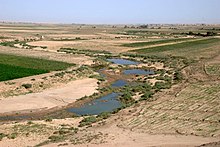
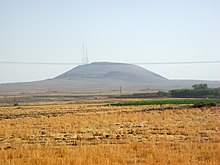
The region mainly lies to the west of theTigris,to the east of theEuphrates,south of theTurkish borderandbordersIraqto the southeast as well as the IraqiKurdistan Regionto the northeast. The region is at latitude approximately 36°30' north and mostly consists of plains and low hills, however there are some mountains in the region such asMount Abdulazizas well as the western part of theSinjar Mountain Rangein the Jazira Region.
In terms ofgovernorates of Syria,the region is formed from parts of theal-Hasakah,Raqqa,Deir ez-Zorand theAleppogovernorates.
History
Background
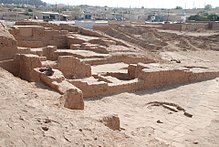
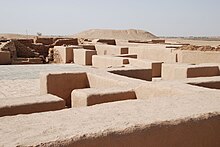
Northern Syria is part of theFertile Crescent,and includes archaeological sites dating to the Neolithic, such asTell Halaf.In antiquity, the area was part of theMitannikingdom, its centre being the Khabur river valley in modern-day Jazira Region. It was then part ofAssyria,with the last surviving Assyrian imperial records, from between 604 BC and 599 BC, were found in and around the Assyrian city ofDūr-Katlimmu.[77]Later it was ruled by different dynasties and empires – theAchaemenidsofIran,theHellenistic empireswho succeededAlexander the Great,theArtaxiadsofArmenia,[78]Rome,the IranianParthiansand[79]Sasanians,[80]then by theByzantinesand successive Arab Islamic caliphates. In course of these regimes, different groups settled in northern Syria, often contributing to population shifts. Arabic tribes have been present in the area for millennia.[81]Under the HellenisticSeleucid Empire(312–63 BC), different tribal groups and mercenaries were settled in northern Syria as military colonists; these included Arabs[82]and possibly Kurds.[83][d]Jan Retso argued that Abai, an Arab settlement where the Seleucid kingAntiochus VI Dionysuswas raised, was located in northern Syria.[82]By the 3rd century, the Arab tribe of the Fahmids lived in northern Syria.[85]
By the 9th century, northern Syria was inhabited by a mixed population of Arabs, Assyrians, Kurds, Turkic groups, and others. Kurdish tribes in the area often operated as soldiers for hire,[84]and were still placed in specific military settlements in the northern Syrian mountains.[86]There existed a Kurdish elite of whichSaladin,[87]the founder of theAyyubid dynastyand the Emir ofMasyafin the 12th century were part of.[88]Under Saladin's rule, northern Syria experienced a mass immigration of Turkic groups who came into conflict with Kurdish tribes, resulting in clashes that wiped out several Kurdish communities.[89]
During theOttoman Empire(1516–1922), largeKurdish-speakingtribal groups both settled in and were deported to areas of northern Syria fromAnatolia.[90][91]By the 18th century, five Kurdish tribes existed in northeastern Syria.[86]The demographics of this area underwent a huge shift in the early part of the 20th century. Some Circassian, Kurdish and Chechen tribes cooperated with the Ottoman (Turkish) authorities in the massacres ofArmenianandAssyrianChristians inUpper Mesopotamia,between 1914 and 1920, with further attacks on unarmed fleeing civilians conducted by local Arab militias.[90][92][91][93]Many Assyrians fled to Syria during the genocide and settled mainly in the Jazira area.[91][94]Starting in 1926, the region saw another immigration of Kurds following the failure of theSheikh Said rebellionagainst theTurkish authorities.[95]While many of the Kurds in Syria have been there for centuries,[96][88][97]waves of Kurds fled their homes in Turkey and settled in SyrianAl-Jazira Province,where they were granted citizenship by theFrench Mandate authorities.[98]The number of Turkish Kurds settled in al-Jazira province during the 1920s was estimated at 20,000 people, out of 100,000 inhabitants, with the remainder of the population being Christians (Syriac, Armenian, Assyrian) and Arabs.[99]: 458
Syria's independence and rule of the Ba'ath Party

FollowingSyria's independence,policies ofArab nationalismand attempts at forcedArabizationbecame widespread in the country's north, to a large part directed against the Kurdish population.[100][101]The region received little investment or development from the central government and laws discriminated against Kurds owning property, driving cars, working in certain professions and forming political parties.[102]Property was routinely confiscated by government loansharks. After theBa'ath Partyseized power in the1963 Syrian coup d'état,non-Arab languages were forbidden at Syrian public schools. This compromised the education of students belonging to minorities like Kurds, Turkmen, and Assyrians.[103][104]Some groups like Armenians, Circassians, and Assyrians were able to compensate by establishing private schools, but Kurdish private schools were also banned.[101][105]Northern Syrian hospitals lacked equipment for advanced treatment and instead patients had to be transferred outside the region. Numerous place names were arabized in the 1960s and 1970s.[104]In his report for the 12th session of the UNHuman Rights CounciltitledPersecution and Discrimination against Kurdish Citizens in Syria,theUnited Nations High Commissioner for Human Rightsheld that "Successive Syrian governments continued to adopt a policy of ethnic discrimination and national persecution against Kurds, completely depriving them of their national, democratic and human rights – an integral part of human existence. The government imposed ethnically-based programs, regulations and exclusionary measures on various aspects of Kurds' lives – political, economic, social and cultural."[106]Kurdish cultural festivals likeNewrozwere effectively banned.[107]
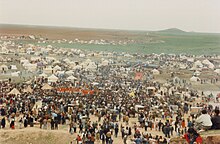
In many instances, the Syrian government arbitrarily deprived ethnic Kurdish citizens of their citizenship. The largest such instance was a consequence of a census in 1962, which was conducted for exactly this purpose. 120,000 ethnic Kurdish citizens saw their citizenship arbitrarily taken away and becamestateless.[101][107][108]This status was passed to the children of a "stateless" Kurdish father.[101]In 2010, theHuman Rights Watch(HRW) estimated the number of such "stateless" Kurdish people in Syria at 300,000.[109][110]In 1973, the Syrian authorities confiscated 750 square kilometres (290 square miles) of fertile agricultural land inAl-Hasakah Governorate,which was owned and cultivated by tens of thousands of Kurdish citizens, and gave it to Arab families brought in from other provinces.[106][105]In 2007, in the Al-Hasakah Governorate, 600 square kilometres (230 square miles) aroundAl-Malikiyahwere granted to Arab families, while tens of thousands of Kurdish inhabitants of the villages concerned were evicted.[106]These and other expropriations was part of the so-called "Arab Belt initiative" which aimed to change the demographic fabric of the resource-rich region.[101]Accordingly, relations between the Syrian government and the Syrian Kurdish population were tense.[111]
The response of northern Syrian parties and movements to the policies ofHafez al-Assad's Ba'athist government varied greatly. Some parties opted for resistance, whereas others such as theKurdish Democratic Progressive Party[112]and theAssyrian Democratic Party[113]attempted to work within the system, hoping to bring about changes through soft pressure.[114]In general, parties that openly represented certain ethnic and religious minorities were not allowed to participate in elections, but their politicians were occasionally allowed to run as Independents.[115]Some Kurdish politicians won seats during theSyrian elections in 1990.[116]The government also recruited Kurdish officials, in particular as mayors, to ease ethnic relations. Regardless, northern Syrian ethnic groups remained deliberately underrepresented in the bureaucracy, and many Kurdish majority areas were run by Arab officials from other parts of the country.[115]Security and intelligence agencies worked hard to suppress dissidents, and most Kurdish parties remained underground movements. The government monitored, though generally allowed this "sub-state activity" because the northern minorities including the Kurds rarely caused unrest with the exception of the2004 Qamishli riots.[115]The situation improved after the death of Hafez al-Assad and the election of his son,Bashar al-Assad,under whom the number of Kurdish officials grew.[117]
Despite theBa'athistinternal policies which officially suppressed a Kurdish identity, the Syrian government allowed theKurdistan Workers' Party(PKK) to set up training camps from 1980. The PKK was a militant Kurdish group led byAbdullah Öcalanwhich waswaging an insurgency against Turkey.Syria and Turkey were hostile toward each other at the time, resulting in the use of the PKK as proxy group.[115][62]The party began to deeply influence the Syrian Kurdish population in theAfrinandAyn al-Arab Districts,where it promoted Kurdish identity through music, clothing, popular culture, and social activities. In contrast, the PKK remained much less popular among Kurds inal-Hasakah Governorate,where other Kurdish parties maintained more influence. Many Syrian Kurds developed a long-lasting sympathy for the PKK, and a large number, possibly more than 10,000, joined its insurgency in Turkey.[115]A rapprochement between Syria and Turkey brought an end to this phase in 1998, when Öcalan and the PKK were formally expelled from northern Syria. Regardless, the PKK maintained a clandestine presence in the region.[115][62]
In 2002, the PKK and allied groups organized theKurdistan Communities Union(KCK) to implement Öcalan's ideas in various Middle Eastern countries. A KCK branch was also set up in Syria, led by Sofi Nureddin and known as "KCK-Rojava". In an attempt to outwardly distance the Syrian branch from the PKK,[62]theDemocratic Union Party(PYD) was established asde factoSyrian "successor" of the PKK in 2003.[115]The "People's Protection Units"(YPG), a paramilitary wing of the PYD, was also founded during this time, but remained dormant.[118]
Establishment of de facto autonomy and war against ISIL

In 2011, acivil uprisingerupted in Syria, prompting hasty government reforms. One of the issues addressed during this time was the status of Syria's stateless Kurds, as President Bashar al-Assad granted about 220,000 Kurds citizenship.[117]In course of the next months, the crisis in Syriaescalated into a civil war.The armedSyrian oppositionseized control of several regions, while security forces were overstretched. In mid-2012 the government responded to this development by withdrawing its military from three mainly Kurdish areas[119][120]and leaving control to local militias. This has been described as an attempt by the Assad regime to keep the Kurdish population out of the initial civil uprising and civil war.[119]
Existing underground Kurdish political parties, namely the PYD and theKurdish National Council(KNC), joined to form theKurdish Supreme Committee(KSC). The People's Protection Units (YPG) militia was reestablished to defend Kurdish-inhabited areas in northern Syria. In July 2012, the YPG established control in the towns ofKobanî,AmudaandAfrin,and the Kurdish Supreme Committee established a joint leadership council to administer the towns. Soon YPG also gained control of the cities ofAl-Malikiyah,Ras al-Ayn,al-Darbasiyah,andal-Muabbadaand parts ofHasakahandQamishli.[121][122][123]Doing so, the YPG and its female wing, theWomen's Protection Units(YPJ), mostly battled factions of theFree Syrian Army,and Islamist militias like theal-Nusra FrontandJabhat Ghuraba al-Sham.It also eclipsed rival Kurdish militias,[124][119]and absorbed some government loyalist groups.[125]According to researcher Charles R. Lister, the government's withdrawal and concurrent rise of the PYD "raised many eyebrows", as the relationship between the two entities was "highly contentious" at the time. The PYD was known to oppose certain government policies, but had also strongly criticised the Syrian opposition.[123]
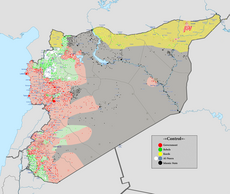
Following a deadly PYD repression of opposition demonstrations in Amuda, the Kurdish National Council withdrew from the Kurdish Supreme Committee. Unopposed, the PYD's political coalition,Movement for a Democratic Society(TEV-DEM), controlled the Kurdish Supreme Committee until the latter was dissolved by the cantonal Democratic Autonomous Administration.[126]On 19 July 2013, the PYD announced that it had written a constitution for an "autonomous Syrian Kurdish region", and planned to hold referendum to approve the constitution in October 2013. Qamishli served as firstde factocapital of the PYD-led governing body,[8]which was official called the "Interim Transitional Administration".[9]The announcement was widely denounced by both moderate as well as Islamist factions of the Syrian opposition.[8]In January 2014, three areas declared their autonomy as cantons (now Afrin Region, Jazira Region and Euphrates Region) and an interimconstitution(also known associal contract) was approved.[127]The Syrian opposition and the Kurdish parties belonging to the KNC condemned this move, regarding the canton system as illegal, authoritarian, and supportive of the Syrian government.[65]The PYD countered that the constitution was open to review and amendment, and that the KNC had been consulted on its drafting beforehand.[128]From September 2014 to spring 2015, the YPG forces in Kobanî Canton, supported by some Free Syrian Army militias and leftist international andKurdistan Workers' Party(PKK) volunteers, fought and finally repelled an assault by theIslamic State of Iraq and the Levant(ISIL) during theSiege of Kobanî,[129]and in the YPG'sTell Abyad offensiveof summer of 2015, the regions of Jazira and Kobanî were connected.[130]
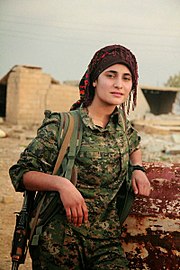
After the YPG victory over ISIL in Kobanî in March 2015, an alliance between YPG and the United States was formed, which greatly worried Turkey, because Turkey stated the YPG was a clone of theKurdistan Workers' Party(PKK) which Turkey (and the U.S. and the E.U.) designate asterrorists.[119]In December 2015, theSyrian Democratic Councilwas created. On 17 March 2016, at a TEV-DEM-organized conference inRmelanthe establishment theDemocratic Federation of Rojava – Northern Syriawas declared in the areas they controlled in Northern Syria.[131]The declaration was quickly denounced by both the Syrian government and theNational Coalition for Syrian Revolutionary and Opposition Forces.[67]
In March 2016,Hediya YousefandMansur Selumwere elected co-chairpersons for the executive committee to organise a constitution for the region, to replace the 2014 constitution.[4]Yousef said the decision to set up a federal government was in large part driven by the expansion of territories captured from Islamic State: "Now, after the liberation of many areas, it requires us to go to a wider and more comprehensive system that can embrace all the developments in the area, that will also give rights to all the groups to represent themselves and to form their own administrations".[132]In July 2016, a draft for the new constitution was presented, based on the principles of the 2014 constitution, mentioning all ethnic groups living in Northern Syria and addressing their cultural, political and linguistic rights.[133][134]The main political opposition to the constitution have beenKurdish nationalists,in particular the KNC, who have different ideological aspirations than the TEV-DEM coalition.[135]On 28 December 2016, after a meeting of the 151-member Syrian Democratic Council inRmelan,a new constitution was resolved; despite objections by 12 Kurdish parties, the region was renamed the "Democratic Federation of Northern Syria", removing the name "Rojava".[136]
Turkish military operations and occupation

Since 2012, when the first YPG pockets appeared, Turkey had been alarmed by the presence of PKK-related forces at its southern border and grew concerned when the YPG entered into an alliance with the US to oppose ISIS forces in the region.[137]The Turkish government refused to allow aid to be sent to the YPG during the Siege of Kobanî. This led to theKurdish riots,the breakdown of the2013–2015 peace processin July 2015 and the renewal ofarmed conflictbetween the PKK and Turkish forces. According to the Turkish pro-government newspaperDaily Sabah,the YPG's parent organisation, the PYD, provided the PKK with militants, explosives, arms and ammunition.[138]
In August 2016, Turkey launchedOperation Euphrates Shieldto prevent the YPG-ledSyrian Democratic Forces(SDF) from linking Afrin Canton (now Afrin Region) with the rest of Rojava and to captureManbijfrom the SDF. Turkish and Turkish-backed Syrian rebel forces prevented the linking of Rojava's cantons and captured all settlements inJarabuluspreviously under SDF control.[139]The SDF handed over part of the region to the Syrian government to act as a buffer zone against Turkey.[140]Manbij remained under SDF control.
In early 2018, Turkey launchedOperation Olive BranchalongsideTurkish-backed Free Syrian Armyto capture the Kurdish-majorityAfrinand oust the YPG/SDF from the region.[141]Afrin Canton,a subdivision of the region, was occupied and over 100,000 civilians were displaced and relocated to Afrin Region'sShahba Cantonwhich remained under SDF, then joint SDF-Syrian Arab Army(SAA) control. The remaining SDF forces later launched anongoing insurgencyagainst the Turkish and Turkish-backed Syrian rebel forces.[142]
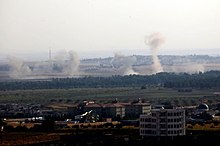
In 2019, Turkey launchedOperation Peace Springagainst the SDF. On 9 October, theTurkish Air Forcelaunched airstrikes on border towns.[143]On 6 OctoberPresident of the United StatesDonald Trumphad ordered United States troops to withdraw from northeastern Syria where they had beenproviding supportto the SDF.[144]Journalists called the withdrawal "a serious betrayal to the Kurds" and "a catastrophic blow to US credibility as an ally and Washington's standing on the world stage"; one journalist stated that "this was one of the worst US foreign policy disasters since theIraq War".[145][146][147][148]Turkish and Turkish-backed Syrian rebel forces captured 68 settlements, includingRas al-Ayn,Tell Abyad,Suluk,MabroukaandManajirduring the 9-day operation before a 120-hour ceasefire was announced.[149][150][151][152][153]The operation was condemned by the international community,[154]and human rights violations by Turkish forces were reported.[155]Media outlets labelled the attack "no surprise" because Turkish presidentRecep Tayyip Erdoğanhad for months warned that the presence of the YPG on the Turkish-Syrian border despite theNorthern Syria Buffer Zonewas unacceptable.[119]An unintended consequence of the attack was that it raised the worldwide popularity and legitimacy of the northeastern Syrian administration, and several PYD and YPG representatives became internationally known to an unprecedented degree. However, these events caused tensions within the KCK, as differences emerged between the PKK and PYD leadership. The PYD was determined to maintain the regional autonomy and hoped for a continued alliance with the United States. In contrast, the PKK central command was now willing to restart negotiations with Turkey, distrusted the United States, and emphasized the international success of its leftist ideology over the survival of Rojava as administrative entity.[62]
Politics
 |
|---|
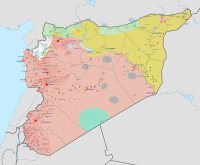
The political system of the region is based on its adopted constitution, officially titled "Charter of the Social Contract".[38][156]The constitution was ratified on 9 January 2014 and provides that all residents of the region shall enjoy fundamental rights such asgender equalityandfreedom of religion.[38]It also provides forproperty rights.[157]The region's system of community government hasdirect democraticaspirations.[158]
The Former diplomatCarne Rossobserved in September 2015 inThe New York Times:[38]
"For a former diplomat like me, I found it confusing: I kept looking for a hierarchy, the singular leader, or signs of a government line, when, in fact, there was none; there were just groups. There was none of that stifling obedience to the party, or the obsequious deference to the" big man "—a form of government all too evident just across the borders, in Turkey to the north, and the Kurdish regional government of Iraq to the south. The confident assertiveness of young people was striking.
However, a 2016 paper fromChatham Housestated that power is heavily centralized in the hands of the Democratic Union Party (PYD).[159]Abdullah Öcalan,aKurdistan Workers' Party(PKK) leaderimprisonedinİmralı,Turkey, has become an iconic figure in the region whose ideology ofdemocratic confederalismhas shaped the region's society and politics.[160]
Besides the parties represented in TEV-DEM and the KNC, several other political groups operate in northern Syria. Several of these, such as theKurdish National Alliance in Syria,[161][162]theDemocratic Conservative Party,[163]theAssyrian Democratic Party,[164]and others actively participate in governing the region.

The politics of the region has been described as having "libertarian transnational aspirations" influenced by the PKK's shift towardanarchism,but also includes various "tribal, ethno-sectarian, capitalist and patriarchal structures."[157]The region has a "co-governance" policy in which each position at each level of government in the region includes a "female equivalent of equal authority" to a male.[165]Similarly, there are aspirations for equal political representation of all ethno-religious components – Arabs, Kurds and Assyrians being the most sizeable ones. This has been compared this to theLebaneseconfessionalistsystem, which is based on that country's major religions.[157][166][167][168]
The PYD-led rule has triggered protests in various areas since they first captured territory. In 2019, residents of tens of villages in the easternDeir ez-Zor Governoratedemonstrated for two weeks, regarding the new regional leadership as Kurdish-dominated and non-inclusive, citing arrests of suspected ISIL members, looting of oil, lack of infrastructure as well as forced conscription into the SDF as reasons. The protests resulted in deaths and injuries.[169]It has been stated that the new political structures created in the region have been based on top-down structures, which have placed obstacles for the return of refugees, created dissent as well as a lack of trust between the SDF and the local population.[170]
Qamishli initially served as thede factocapital of the administration,[8][133]but the area's governing body later relocated toAyn Issa.[1]
Administrative divisions

Article 8 of the 2014 constitution stipulates that "All Cantons in the autonomous regions are founded on the principle of local self-government. Cantons may freely elect their representatives and representative bodies, and may pursue their rights insofar as it does not contravene the articles of the Charter."[156]
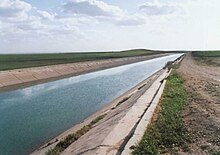
The cantons were later reorganized into regions with subordinate cantons/provinces, areas, districts and communes. The firstcommunal electionsin the region were held on 22 September 2017. 12,421 candidates competed for around 3,700 communal positions during the elections, which were organized by the region's High Electoral Commission.[171][172]Elections for the councils of the Jazira Region, Euphrates Region and Afrin Region were held inDecember 2017.[16]Most of Afrin Region was occupied by Turkish-led forces in early 2018, though the administrative division continued to operate fromTell Rifaatwhich is under joint YPG-Syrian Army control.[75][173][174]
On 6 September 2018, during a meeting of theSyrian Democratic CouncilinAyn Issa,a new name for the region was adopted, the "Autonomous Administration of North and East Syria", encompassing the Euphrates, Afrin, and Jazira regions as well as the local civil councils in the regions of Raqqa, Manbij, Tabqa, and Deir ez-Zor. During the meeting, a 70-member "General Council for the Autonomous Administration of North and East Syria" was formed.[75][1][76]
| Regions | Official name (languages) | Prime Ministers | Deputy Prime Ministers | |
|---|---|---|---|---|
| Jazira Region |
|
Akram Hesso | Elizabeth Gawrie Hussein Taza Al Azam | |
| Euphrates Region |
|
Enver Muslim | Bêrîvan Hesen Xalid Birgil | |
| Afrin Region (in exile) |
|
Hêvî Îbrahîm | Remzi Şêxmus Ebdil Hemid Mistefa | |
| Raqqa Region |
|
N/A | N/A | |
| Tabqa Region |
|
N/A | N/A | |
| Manbij Region |
|
N/A | N/A | |
| Deir ez-Zor Region |
|
N/A | N/A | |
Legislature

In December 2015, during a meeting of the region's representatives inAl-Malikiyah,theSyrian Democratic Council(SDC) was established to serve as the political representative of theSyrian Democratic Forces.[175]The co-leaders selected to lead the SDC at its founding were prominent human rights activistHaytham MannaandTEV-DEMExecutive Board member Îlham Ehmed.[176][177]The SDC appoints an Executive Council which deal with the economy, agriculture, natural resources, and foreign affairs.[178]General elections were planned for 2014 and 2018,[178]but this was postponed due to fighting.
Education, media, and culture
School
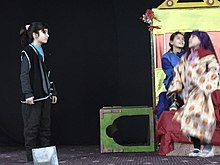
Under the rule of theBa'ath Party,school education consisted of onlyArabiclanguage public schools, supplemented by Assyrian private confessional schools.[179]In 2015, the region's administration introduced primary education in thenative language(eitherKurdishor Arabic) and mandatorybilingualeducation (Kurdish and Arabic) for public schools,[180][181][182]with English as a mandatory third language.[183]There are ongoing disagreements and negotiations over curriculums with the Syrian central government,[184][185]which generally still pays the teachers in public schools.[180][186][187][188]

In August 2016, the Ourhi Centre was founded by the Assyrian community in the city of Qamishli, to educate teachers in order to makeSyriac-Aramaican additional language in public schools in Jazira Region,[189]which then started in the 2016/17 academic year.[185]According to the region's Education Committee, in 2016/2017 "three curriculums have replaced the old one, to include teaching in three languages: Kurdish, Arabic and Syriac."[190]In August 2017 Galenos Yousef Issa of the Ourhi Centre announced that the Syriac curriculum would be expanded to grade 6, which earlier had been limited to grade 3, with teachers being assigned to Syriac schools inAl-Hasakah,Al-QahtaniyahandAl-Malikiyah.[191][192]At the start of the academic year 2018–2019, the curricula in Kurdish and Arabic had been expanded to grades 1–12 and Syriac to grades 1–9. "Jineology"classes had also been introduced.[193]In general, schools are encouraged to teach the administration's "uptopian doctrine" which promotes diversity, democracy, and the ideas ofAbdullah Öcalan.[35][194]Local reactions to the changes to the school system and curriculum were mixed. While many praised the new system because it encouraged tolerance and allowed Kurds and other minorities to be taught in their own languages,[35]others have criticised it asde factocompulsory indoctrination.[195]
The federal, regional and local administrations in the region put much emphasis on promoting libraries and educational centers, to facilitate learning and social and artistic activities. Examples are the Nahawand Center for Developing Children's Talents inAmuda(est. 2015) and the Rodî û Perwîn Library inKobani(May 2016).[196]
For Assyrian private confessional schools there had at first been no changes.[185][197]However, in August 2018 it was reported that the region's authorities was trying to implement its own Syriac curriculum in private Christian schools that have been continuing to use an Arabic curriculum with limited Syriac classes approved by the Assad regime and originally developed by Syrian Education Ministry in cooperation with Christian clergy in the 1950s. The threatening of the closure of schools not complying with this resulted in protests erupting in Qamishli.[198][199][200]A deal was later reached in September 2018 between the region's authorities and the local Syriac Orthodox archbishopric, where the two first grades in these schools would learn the region's Syriac curriculum and grades three to six would continue to learn the Damascus approved curriculum.[201][202]
Higher education
While there was no institution of tertiary education on the territory of the region at the onset of the Syrian Civil War, an increasing number of such institutions have been established by the regional administrations in the region since.
- In September 2014, theMesopotamian Social Sciences Academyin Qamishli started classes.[38]More such academies designed under a non-traditional academic philosophy and concept are in the process of founding or planning.[203]
- In August 2015, the traditionally-designedUniversity of Afrinin Afrin started teaching, with initial programs in literature, engineering and economics, including institutes for medicine, topographic engineering, music and theater, business administration and the Kurdish language.[204]After the Turkish army invaded Afrin in 2018, several of it students were transferred to theUniversity of Rojavain Qamishli.[205]
- In July 2016, Jazira Canton Board of Education started the University of Rojava in Qamishli, with faculties for Medicine, Engineering, Sciences, and Arts and Humanities. Programs taught include health, computer and agricultural engineering; physics, chemistry, history, psychology, geography, mathematics and primary school teaching and Kurdish literature.[196][206]There is an additional Faculty for Petroleum and Pharmacology inRmelan.[205]Its language of instruction is Kurdish, and with an agreement withParis 8 Universityin France for cooperation, the university opened registration for students in the academic year 2016–2017.[207]
- In August 2016Jazira Cantonpolice forcestook controlof the remaining parts ofHasakahcity, which included the Hasakah campus of the Arabic-languageAl-Furat University,and with mutual agreement the institution continues to be operated under the authority of the Damascus government's Ministry of Higher Education.
Media
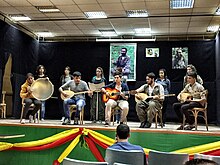
Incorporating theUniversal Declaration of Human Rights,theInternational Covenant on Civil and Political Rights,theInternational Covenant on Economic, Social and Cultural Rights,as well as other internationally recognized human rights conventions, the 2014Constitution of North and East Syriaguaranteesfreedom of speechandfreedom of the press.As a result, a diverse media landscape has developed in the region,[208][209]in each of theKurdish,Arabic,Syriac-AramaicandTurkishlanguages of the land, as well as in English, and media outlets frequently use more than one language. Among the most prominent media in the region areHawar News AgencyandARA Newsagencies and websites as well as TV outlets Rojava Kurdistan TV,Ronahî TV,and the bimonthly magazineNudem.A landscape of local newspapers and radio stations has developed. However, media agencies often face economic pressure, as was demonstrated by the closure of news websiteWelatiin May 2016.[210]In addition, the autonomous regions have imposed some limits on press freedom, for example forcing the press to get work permits. These can be cancelled, thereby curtailing the ability of certain press agencies to operate. However, the extent of these restrictions differed greatly from area to area. By 2016, Kobani Canton was the least restrictive, followed by Jazira Canton which closely monitored and occasionally regulated press activity.[211]Afrin Canton was the most restrictive, and many local reporters operated anonymously.[212]
Political extremism in the context of the Syrian Civil War can put media outlets under pressure; for example in April 2016 the premises ofArta FM( "the first, and only, independent radio station staffed and broadcast by Syrians inside Syria" ) inAmudawas threatened and burned down by unidentified assailants.[213][214]In December 2018 the Rojava Information Center was established.[215]During theTurkish military operation in Afrin,theKDP-affiliated Iraqi KurdishRudaw Media Networkwas also banned from reporting in the region.[216]On 2 September 2019, theIraqi Kurdistan-basedKurdistan 24network had its license to work in the region withdrawn and had its offices confiscated by Rojava authorities.[217]International media and journalists operate with few restrictions in the region, one of the only regions in Syria where they can operate with some degree of freedom.[209]Internet connections in the region are often slow due to inadequate infrastructure. Internet lines are operated bySyrian Telecom,which as of January 2017 is working on a major extension of the fibre optic cable network in southern Jazira Region.[218]
The arts

After the establishment of the de facto autonomous region, the Center of Art and Democratic Culture, located in Jazira Region, has become a venue for aspiring artists who showcase their work.[219][220]Among major cultural events in the region is the annualFestival of Theaterin March/April as well as theRojava Short Story Festivalin June, both in the city of Qamishli, and theAfrin Short Film Festivalin April.[221]
Economy
The Jazira Region is a major wheat and cotton producer and has a considerable oil industry. The Euphrates Region suffered most destruction of the three regions and has huge challenges in reconstruction, and has recently seen somegreenhouseagriculture construction. The Afrin Region has had a traditional specialization on olive oil includingAleppo soapmade from it, and had drawn much industrial production from the nearby city ofAleppodue to thefighting in Aleppo cityfrom 2012 to 2016.Price controlsare managed by local committees, which can set the price of basic goods such as food and medical goods.[222]
It has been theorized that the Assad government had deliberately underdeveloped parts of Northern Syria in order to Arabize the region and make secession attempts less likely.[223]During the Syrian Civil War, the infrastructure of the region on average experienced less destruction than other parts of Syria. In May 2016, Ahmed Yousef, head of the Economic Body and chairman of Afrin University, stated that at the time, the economic output of the region (including agriculture, industry and oil) accounted for about 55% of Syria's gross domestic product.[224]In 2014, the Syrian government was still paying some state employees,[225]but fewer than before.[226]However, the administration of the region stated that "none of our projects are financed by the regime".[227]

At first, there were nodirectorindirect taxeson people or businesses in the region; instead, the administration raised money mainly throughtariffsand selling oil and other natural resources.[228][222]However, in July 2017, it was reported that the administration in the Jazira Region had started to collectincome taxto provide for public services in the region.[229]In May 2016, TheWall Street Journalreported that traders in Syria experience the region as "the one place where they aren't forced to pay bribes."[230]The highest amount of energy is produced by theTabqa Damat theEuphratesriver, Syrians largest.[231]
The main sources of revenue for the autonomous region have been presented as: 1. Public properties such as grain silos and oil and gas in the Jazira Region, 2. Local taxation and customs fees taken at the border crossings, 3. Service delivery, 4. Remittances from Iraq and Turkey, and 5. Local donations. In 2015, the autonomous administration shared information about the region's finances where its 2014 revenue was about LS 3 billion (≈US$5.8 million) of which 50% was spent on "self-defense and protection", 18% for the Jazira Canton (now Jazira Region), 8.5% for the Kobani Canton (now Euphrates Region), 8.5% for the Afrin Canton (now Afrin Region), 15% for the "Internal Committee" and any remainder was a reserve for the next year.[66]The AANES has by far the highest averagesalariesandstandard of livingthroughout Syria, with salaries being twice as large as in regime-controlled Syria, following the collapse of theSyrian poundthe AANES doubled salaries to maintaininflation,and allow for good wages.[232]The AANES still faces challenges with distribution,food security,andhealthcare.[233][234]
External economic relations
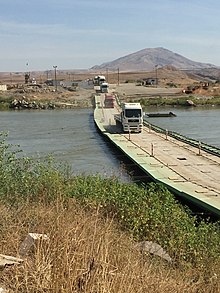
Oil and food production is substantial,[178]so they are important exports. Agricultural products include sheep, grain and cotton. Important imports are consumer goods and auto parts.[235]Trade with Turkey and access to humanitarian and military aid is difficult due to a blockade by Turkey.[236]Turkey does not allow business people or goods to cross its border.[237]The blockade from adjacent territories held by Turkey and ISIL, and partially also the KRG, temporarily caused heavy distortions of relative prices in Jazira Region and Euphrates Region (while separate, Afrin Region borders government-controlled territory since February 2016); for example in Jazira Region and Euphrates Region, through 2016 petrol cost only half as much as bottled water.[238]
TheSemalka Border CrossingwithIraqi Kurdistanhad been intermittently closed by theKurdistan Regional Government(KRG), but has been open permanently since June 2016,[239][240]and along with the establishment of a corridor to Syrian government controlled territory in April 2017,[241]economic exchange has increasingly normalized. Further, in May 2017 in northern Iraq, thePopular Mobilization Forcesfighting ISIL cleared a corridor connecting the autonomous region and Iraqi government-controlled territory.[242][243][244]
Economy policy framework
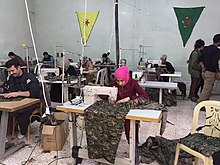
The autonomous region is ruled by a coalition which have been described as pursuing a model of economy that blends co-operative and private enterprise.[245]In 2012, the PYD launched what it called the "Social Economy Plan", later renamed the "People's Economy Plan" (PEP).[246]Private propertyand entrepreneurship are protected under the principle of "ownership by use". Dr. Dara Kurdaxi, a regional official, has stated: "The method in Rojava is not so much against private property, but rather has the goal of putting private property in the service of all the peoples who live in Rojava."[247]Communes and co-operatives have been established to provide essentials.[248]Co-operatives account for a large proportion of agricultural production and are active in construction, factories, energy production, livestock, pistachio and roasted seeds, and public markets.[245]Several hundred instances ofcollective farmingoccurred across towns and villages in the region, with communes consisting of approximately 20–35 people.[249]According to the region's "Ministry of Economics", approximately three-quarters of all property has been placed under community ownership and a third of production has been transferred to direct management byworkers' councils.[250]
Law and security

Legal system
Syrian civil laws are valid in the region if they do not conflict with the Constitution of the autonomous region. One example for amendment is personal status law, which in Syria is based onSharia[251]and applied bySharia Courts,[252]while thesecularautonomous region proclaims absolute equality of women under the law, allowingcivil marriageand banningforced marriage,polygamy[253][254]and underage marriage.[255][256]
A new criminal justice approach was implemented that emphasizesrestorationover retribution.[257]The death penalty was abolished.[258]Prisons house mostly people charged with terrorist activity related to ISIL and other extremist groups.[259]A September 2015 report ofAmnesty Internationalstated that 400 people were incarcerated by the region's authorities and criticized deficiencies indue processof the judicial system of the region.[260][38][261]
At the local level, citizens createPeace and Consensus Committees,which make group decisions on minor criminal cases and disputes as well as in separate committees resolve issues of specific concern to women's rights like domestic violence and marriage. At the regional level, citizens (who need not be trained jurists) are elected by the regionalPeople's Councilsto serve on seven-memberPeople's Courts.At the next level are fourAppeals Courts,composed of trained jurists. The court of last resort is theRegional Court,which serves the region as a whole. Separate from this system, theConstitutional Courtrenders decisions on compatibility of acts of government and legal proceedings with the constitution of the region (called the Social Contract).[258]
Policing and security

Policing in the region is performed by theAsayisharmed formation. Asayish was established on 25 July 2013 to fill the gap of security when the Syrian security forces withdrew.[262]Under theConstitution of North and East Syria,policing is a competence of the regions. The Asayish forces of the regions are composed of 26 official bureaus that aim to provide security and solutions to social problems. The six main units of Asayish are Checkpoints Administration, Anti-Terror Forces Command (HAT), Intelligence Directorate, Organized Crime Directorate, Traffic Directorate and Treasury Directorate. 218 Asayish centers were established and 385 checkpoints with 10 Asayish members in each checkpoint were set up. 105 Asayish offices provide security against ISIL on the frontlines across Northern Syria. Larger cities have general directorates responsible for all aspects of security including road controls. Each region has a HAT command, and each Asayish center organizes itself autonomously.[262]
Throughout the region, the municipal Civilian Defense Forces (HPC)[263]and the regionalSelf-Defense Forces(HXP)[264]also serve local-level security. In Jazira Region, the Asayish are further complemented by the AssyrianSutoropolice force, which is organized in every area with Assyrian population, provides security and solutions to social problems in collaboration with other Asayish units.[262]TheKhabour GuardsandNattoreh,though not police units, also have a presence in the area, providing security in towns along theKhabur River.TheBethnahrain Women's Protection Forcesalso maintain a police branch. In the areas taken from ISIL during theRaqqa campaign,theRaqqa Internal Security Forcesand Manbij Internal Security Forces operate as police forces. Deir ez-Zor also maintain an Internal Security Forces unit.
Militias
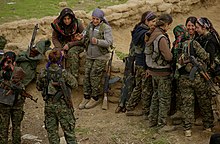

The main military force of the region is theSyrian Democratic Forces,an alliance of Syrian rebel groups formed in 2015. The SDF is led by the Kurdish majorityPeople's Protection Units(Yekîneyên Parastina Gel,YPG). The YPG was founded by thePYDafter the2004 Qamishli clashes,but was first active in the Syrian Civil War.[265]There is also theSyriac Military Council(MFS), an Assyrian militia associated with theSyriac Union Party.There are alsoFree Syrian Armygroups in the alliance such asJaysh al-Thuwarand theNorthern Democratic Brigade,tribal militias like the ArabAl-Sanadid Forces,and municipal military councils in theShahba region,like theManbij Military Council,theAl-Bab Military Councilor theJarablus Military Council.
TheSelf-Defence Forces(HXP) is a territorial defense militia and the only conscript armed force in the region. HXP is locally recruited to garrison their municipal area and is under the responsibility and command of the respective regions of the NES. Occasionally, HXP units have supported the YPG, and SDF in general, during combat operations against ISIL outside their own municipality and region.
Human rights
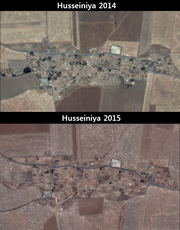
In the course of the Syrian Civil War, including the years 2014 and 2015, reports byHuman Rights Watch(HRW) andAmnesty Internationalstated thatmilitias associated with the autonomous regionwere committing war crimes, in particular members of thePeople's Protection Units(YPG).[266][267]The reports from 2014 include reports of arbitrary arrests and torture, other reports include the use ofchild soldiers.[268][269][270]After the report, the YPG publicly accepted the deficiencies[268]and in October 2015 the YPG demobilized 21 minors from the military service in its ranks.[271]Reports have been comprehensively debated and contested by both the YPG and other human rights organizations.[272][273]In 2018, HRW again accused the YPG of recruiting minors. The YPG responded that if 16- and 17-year-olds are hired, the relatives are notified, but do not have to consent, and the minors are kept away from combat zones.[274]Since September 2015, the YPG have received human rights training fromGeneva Calland other international organizations.[275]A September 2020 article fromSyria Directfound that the SDF was continuing to recruit child soldiers, despite signing an action plan on July 1, 2019, with theUnited Nationsto "end and prevent the recruitment and use of child soldiers."[276]

The region's civil government has been hailed in international media for human rights advancement in particularin the legal system,concerningwomen's rights,ethnic minority rights,freedom of Speech and Pressand forhosting inbound refugees.[277][278][279][280]The political agenda of "trying to break the honor-based religious and tribal rules that confine women" is controversial in conservative quarters of society.[255]Conscription into theSelf-Defence Forces(HXP) has been called a human rights violation by those who call the region's institutions illegitimate.[281]
Some persistent issues in the region concernethnic minority rights.One issue of contention is the consequence ofBaathist Syrian government's expropriationof land from Kurdish owners and settling of tribal Arabs there in 1973 and 2007.[106][101][105]There have been calls to expel the settlers and return the land to its previous owners, which has led the political leadership of the region to press the Syrian government for a comprehensive solution.[282]
During the ongoing Syrian Civil War, organizations such as the Turkish government,[283]Amnesty International[284]and the Middle East Observer[285][286]have stated that SDF was forcibly displacing inhabitants of captured areas with predominantly Arab population such as Tell Abyad. These displacements were considered attempts atethnic cleansing.[287]However, the head of theSyrian Observatory for Human Rightsrebutted these reports[288]and the UN Independent International Commission of Inquiry find no evidence of YPG or SDF forces committing ethnic cleansing in order to change the demographic composition of territories under their control.[45]
Demographics
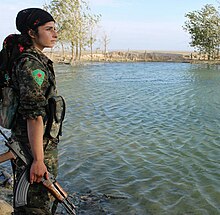
The demographics of the region have historically been highly diverse, with several major shifts in regard to which groups form majorities or minorities in the last centuries.[e]TheAl-Hasakah Governoratehistorically been the domain of nomad and sedentary Arabs.[293]Most of the Kurdish population in the area have immigrated from Turkey during the 20th century.[294]One major shift in modern times was in the early part of the 20th century due to theAssyrianandArmenian genocides,when many Assyrians and Armenians fled to Syria from Turkey. In the 1920s after the failedKurdish rebellionsinKemalist Turkey,there was a large influx of Kurds to Syria's northeast, called "Jazira province" at the time. It is estimated that 25,000 Kurds fled at this time to Syria, underFrench Mandate authorities,who encouraged their immigration,[295]and granted them Syrian citizenship.[296]Consequently, the French official reports show the existence of at most 45 Kurdish villages in Jazira prior to 1927. A new wave of refugees arrived in 1929.[297]The mandatory authorities continued to encourage Kurdish immigration into Syria, and by 1939, the villages numbered between 700 and 800.[297]Another account by Sir John Hope Simpson estimated the number of Kurds in Jazira province at 20,000 out of 100,000 people at the end of 1930.[99]: 556 The number of Kurds continued to grow and the French geographers Fevret and Gibert estimated that in 1953 out of the total 146,000 inhabitants of Jazira, agriculturalist Kurds made up 60,000 (41%), nomad Arabs 50,000 (34%), and a quarter of the population were Christians.[293]
Under the French Mandate of Syria, newly arriving Kurds were granted citizenship byFrench Mandate authorities[98]and enjoyed considerable rights as the French Mandate authority encouraged minority autonomy as part of adivide and rulestrategy and recruited heavily from the Kurds and other minority groups, such asAlawiteandDruze,for its local armed forces.[298]The last significant wave of Kurdish incoming migration from Turkey happened between 1945 and 1961 which strongly contributed to the growth of al-Hasakah Governorate's population from 240,000 to 305,000 between 1954 and 1961.[299]In addition to the demographic changes brought about by the Kurdish immigration from Turkey, the Syrian government initiated Arabization policy. Therefore, 4000 Arab families from areas flooded by the Tabqa Dam in Raqqa and Aleppo were resettled in new village in al-Hasakah Governorate.[100][101]
Another shift in modern times was the Baath policy of settling additional Arab population in northern Syria, while displacing local Kurds.[100][101]Most recently, during the Syrian Civil War, many refugees have fled to the north of the country. Some ethnic Arab citizens from Iraq have fled to northern Syria as well.[280][300][301]However, as of January 2018, only two million people are estimated to remain in the area under the region's administration with estimates of around half a million people emigrating since the beginning of the civil war, to a large degree because of the economic hardships the region has faced during the war.[7]As result of the civil war, estimates as to the ethnic composition of northern Syria vary widely, ranging from claims about a Kurdish majority and Arab minority to claims about Kurds being a small minority;[302]Al Jazeerastated in October 2019 that just 10 percent of the 4.5 million inhabitants of northern and northeastern Syria were Kurds.[303]
Ethnic groups
Two ethnic groups have a significant presence throughout Northern Syria:
- Kurdsare anethnic group[304]living in northeastern and northwestern Syria, culturally and linguistically classified among theIranian peoples.[305][306]Many Kurds consider themselves descended from the ancient Iranian people of theMedes,[307]using a calendar dating from 612 BC, when theAssyriancapital ofNinevehwas conquered by the Medes.[308]Kurds formed 55% of the 2010 population of what now is both Jazira Region and Euphrates Region.[223]
- Arabsare anethnic group[309][310][311][312][313]orethnolinguistic group[314][315][316]living throughout Northern Syria, mainly defined byArabicas theirfirst language.They encompassBedouintribes who trace their ancestry to theArabian Peninsulaas well asarabizedindigenous peoples and preexisting Arab groups.[317][318]Arabs form the majority or plurality in some parts of Northern Syria, in particular in the southern parts of the Jazira Region, inTell Abyad Districtand inAzaz District.While inShahba regionthe term Arab is mainly used to denote arabized Kurds[223]and arabizedSyrians,[317]in Euphrates Region and in Jazira Region it mainly denotes ethnic Arab Bedouin populations.[318]
Two ethnic groups have a significant presence in certain regions of Northern Syria:
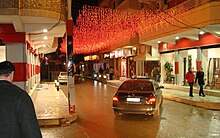
- Assyriansare anethnic group.[319]Their presence in Syria is in theJazira Regionof the autonomous region, particularly in the urban areas (Qamishli,al-Hasakah,Ras al-Ayn,Al-Malikiyah,Al-Qahtaniyah), in the northeastern corner and in villages along theKhabur Riverin theTell Tamerarea. They traditionally speak varieties ofNortheastern Neo-Aramaic,a Semitic language.[320]There are many Assyrians among recent refugees to Northern Syria, fleeing Islamist violence elsewhere in Syria back to their traditional lands.[321]In the secular polyethnic political climate of the region, theDawronoyemodernization movement has a growing influence on Assyrian identity in the 21st century.[32]
- Turkmenare anethnic groupwith a major presence in the area between Afrin Region and Euphrates Region, where they form regional majorities in the countryside fromAzazandMare'toJarabulus,and a minor presence in Afrin Region and Euphrates Region.
There are also smaller minorities ofArmeniansthroughout Northern Syria as well asChechensinRas al-Ayn.
Languages

Regarding the status of different languages in the autonomous region, its "Social Contract" stipulates that "all languages in Northern Syria are equal in all areas of life, including social, educational, cultural, and administrative dealings. Every people shall organize its life and manage its affairs using its mother tongue."[322]In practice, Arabic and Kurmanji are predominantly used across all areas and for most official documents, with Syriac being mainly used in the Jazira Region with some usage across all areas while Turkish and Circassian are also used in the region of Manbij.
The four main languages spoken in Northern Syria are the following, and are from three different language families:
- Kurdish(inNorthern Kurdishdialect), aNorthwestern Iranian language[323][324]from theIndo-European language family.
- Arabicin theNorth Mesopotamian Arabicdialect (Modern Standard Arabicin education and writing), aCentral Semitic languagefrom theSemitic branchof theAfroasiatic language family.
- Eastern Aramaic languagesmainly in theTuroyoandAssyrian Neo-Aramaicvarieties (mainlySyriacin education and writing),Northwest Semitic languagesfrom theSemitic branchof theAfroasiatic language family.
- Turkish(inSyrian Turkmendialect), from theTurkic language family.
For these four languages, three different scripts are in use in Northern Syria:
- TheLatin alphabetfor Kurdish, Turkish and Turoyo
- TheArabic alphabet (abjad)for Arabic
- TheSyriac alphabetfor Syriac, Turoyo and Assyrian Neo-Aramaic
Religion
Most ethnic Kurdish and Arab people in Northern Syria adhere toSunni Islam,while ethnic Assyrian people generally areSyriac Orthodox,Chaldean Catholic,Syriac Catholicor adherents of theAssyrian Church of the East.There are also adherents to other religions, such asYazidism.[325]The dominant PYD party and the political administration in the region are decidedlysecular.[32][326]
Population centres
This list includes all cities and towns in the region with more than 10,000 inhabitants. The population figures are given according to the 2004 Syrian census.[327]
Cities highlighted in light grey are partially under the civil control of the Syrian government.[328][329][330][331]
| English Name | KurdishName | ArabicName | SyriacName | TurkishName | Population | Region |
|---|---|---|---|---|---|---|
| Raqqa | Reqa | الرقة | ܪܩܗ | Rakka | 220,488 | Raqqa |
| Al-Hasakah | Hesîçe | الحسكة | ܚܣܟܗ | Haseke | 188,160 | Jazira |
| Qamishli | Qamişlo | القامشلي | ܩܡܫܠܐ | Kamışlı | 184,231 | Jazira |
| Manbij | Menbîç | منبج | ܡܒܘܓ | Münbiç | 99,497 | Manbij |
| Tabqa | Tebqa | الطبقة | ܛܒܩܗ | Tabka | 69,425 | Tabqa |
| Kobani | Kobanî | عين العرب | ܟܘܒܐܢܝ | Arappınar | 44,821 | Euphrates |
| Hajin | Hecîn | هجين | ܗܓܝܢ | 37,935 | Deir Ez-Zor | |
| Amuda | Amûdê | عامودا | ܥܐܡܘܕܐ | Amudiye | 26,821 | Jazira |
| Al-Malikiyah | Dêrika Hemko | المالكية | ܕܪܝܟ | Deyrik | 26,311 | Jazira |
| Gharanij | غرانيج | ܓܪܐܢܝܓ | 23,009 | Deir Ez-Zor | ||
| Abu Hamam | Ebû Hemam | أبو حمام | ܐܒܘ ܚܡܐܡ | 21,947 | Deir Ez-Zor | |
| Tell Rifaat | Arfêd | تل رفعت | ܬܠ ܪܦܥܬ | Tel Rıfat | 20,514 | Afrin |
| Al-Shaafah | الشعفة | ܫܥܦܗ | 18,956 | Deir Ez-Zor | ||
| Al-Qahtaniyah | Tirbespî | القحطانية | ܩܒܪ̈ܐ ܚܘܪ̈ܐ | Kubur el Bid | 16,946 | Jazira |
| Al-Mansurah | المنصورة | ܡܢܨܘܪܗ | 16,158 | Tabqa[332] | ||
| Al-Shaddadah | Şeddadê | الشدادي | ܫܕܐܕܝ | Şaddadi | 15,806 | Jazira |
| Al-Muabbada | Girkê Legê | المعبدة | ܡܥܒܕܗ | Muabbada | 15,759 | Jazira |
| Al-Kishkiyah | الكشكية | ܟܫܟܝܗ | 14,979 | Deir Ez-Zor | ||
| Al-Sabaa wa Arbain | Seba û Erbîyn | السبعة وأربعين | ܣܒܥܗ ܘܐܪܒܥܝܢ | El Seba ve Arbayn | 14,177 | Jazira |
| Rmelan | Rimêlan | رميلان | ܪܡܝܠܐܢ | Rimelan | 11,500 | Jazira |
| Al-Baghuz Fawqani | Baxoz | الباغوز فوقاني | ܒܐܓܘܙ ܦܘܩܐܢܝ | 10,649 | Deir Ez-Zor |
Health
Healthcare is organized through the region's "Health and Environment Authority" and through sub-region and canton-level Health Committees.[333][334][335][336]Independent organizations providing healthcare in the region include theKurdish Red Crescent,theSyrian American Medical Society,theFree Burma RangersandDoctors Without Borders.The2019 Turkish offensiveleft thousands of people in the region without access to basic necessities as the majority of international aid groups withdrew during the violence.[337][338]
External relations
Relations with the Syrian government

Currently, the relations of the region to theDamascus governmentare determined by the context of the Syrian civil war. TheConstitution of Syriaand theConstitution of North and East Syriaare legally incompatible with respect to legislative and executive authority. In the military realm, combat between thePeople's Protection Units(YPG) and Syrian government forces has been rare, in the most instances some of the territory still controlled by the Syrian government in Qamishli and al-Hasakah has been lost to the YPG. In some military campaigns, in particular in northern Aleppo governate and in al-Hasakah, YPG and Syrian government forces have tacitly cooperated against Islamist forces, the Islamic State of Iraq and the Levant (ISIL) and others.[20]
The region does not state to pursue full independence but rather autonomy within a federal and democratic Syria.[41]
In March 2015, the Syrian Information Minister announced that his government considered recognizing the Kurdish autonomy "within the law and constitution".[339]While the region's administration is not invited to theGeneva III peace talks on Syria,[340]or any of the earlier talks, Russia in particular calls for the region's inclusion and does to some degree carry the region's positions into the talks, as documented in Russia's May 2016 draft for a new constitution for Syria.[341]In October 2016, there were reports of a Russian initiative for federalization with a focus on northern Syria, which at its core called to turn the existing institutions of the region into legitimate institutions of Syria; also reported was its rejection for the time being by the Syrian government.[282]The Damascus ruling elite is split over the question whether the new model in the region can work in parallel and converge with the Syrian government, for the benefit of both, or if the agenda should be to centralize again all power at the end of the civil war, necessitating preparation for ultimate confrontation with the region's institutions.[342]
An analysis released in June 2017 described the region's "relationship with the regime fraught but functional" and a "semi-cooperative dynamic".[343]In late September 2017, Syria's Foreign Minister said that Damascus would consider granting Kurds more autonomy in the region once ISIL is defeated.[344]
On 13 October 2019, the SDF announced that it had reached an agreement with the Syrian Army which allowed the latter to enter the SDF-held cities of Manbij and Kobani in order to dissuade a Turkish attack on those cities as part of the cross-border offensive by Turkish and Turkish-backed Syrian rebels.[345]The Syrian Army also deployed in the north of Syria together with the SDF along the Syrian-Turkish border and entered into several SDF-held cities such as Ayn Issa and Tell Tamer.[346][347]Following the creation of theSecond Northern Syria Buffer Zonethe SDF stated that it was ready to merge with the Syrian Army if or when a political settlement between the Syrian government and the SDF is achieved.[348]
Kurdish issues

The region's dominant political party, theDemocratic Union Party(PYD), is a member organisation of theKurdistan Communities Union(KCK) organization; however, the other KCK member organisations in the neighbouring states (Turkey, Iran and Iraq) with Kurdish minorities are either outlawed (Turkish Kurdistan,Iranian Kurdistan) or politically marginal with respect to other Kurdish parties (Iraq). Expressions of sympathy for Syrian Kurds have been numerous amongKurds in Turkey.[349]During theSiege of Kobanî,some ethnic Kurdish citizens of Turkey crossed the border and volunteered in the defense of the town.[350][351]
The region's relationship with theKurdistan Regional Governmentin Iraq is complicated. One context is that the governing party there, theKurdistan Democratic Party(KDP), views itself and its affiliated Kurdish parties in other countries as a more conservative and nationalist alternative and competitor to the KCK political agenda and blueprint in general.[41]The political system of Iraqi Kurdistan[352]stands in stark contrast to the region's system. Like the KCK umbrella organization, the PYD has some anti-nationalist ideological leanings while having Kurdish nationalist factions as well.[353]They have traditionally been opposed by the Iraqi-Kurdish KDP-sponsoredKurdish National Councilin Syria with more clear Kurdish nationalist leanings.[354]
International relations
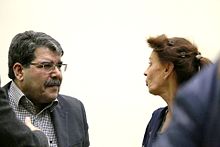
Aside of the representation offices the AANES has established in France, Sweden, Germany and Switzerland[355]the region's role in the international arena is comprehensive military cooperation of its militias under theSyrian Democratic Forces(SDF) umbrella with the United States and theinternational (US-led) coalition against the Islamic State of Iraq and the Levant.[356][357]In a public statement in March 2016, the day after the declaration of the regions autonomy, U.S. Defense Secretary Ashton Carter praised thePeople's Protection Units(YPG) militia as having "proven to be excellent partners of ours on the ground in fighting ISIL. We are grateful for that, and we intend to continue to do that, recognizing the complexities of their regional role."[358]Late October 2016, U.S. Army Lt. Gen.Stephen Townsend,the commander of the international Anti-ISIL-coalition, said that the SDF would lead the impendingassault on Raqqa,ISIL's stronghold and capital, and that SDF commanders would plan the operation with advice from American and coalition troops.[359]At various times, the U.S. deployed U.S. troops embedded with the SDF to the border between the region and Turkey, in order to deter Turkish aggressions against the SDF.[360][361][362][363][364]In February 2018, theUnited States Department of Defensereleased a budget blueprint for 2019 with respect to the region, which included $300 million for theSyrian Democratic Forces(SDF) and $250 million for border security.[365]In April 2018, the President ofFrance,Emmanuel Macrondispatched troops toManbijandRmelanin a bid to assistSyrian Democratic Forces(SDF) militias and in order to defuse tensions with Turkey.[366]

In the diplomatic field, the de facto autonomous region lacks any formal recognition. While there is comprehensive activity of reception of the region's representatives[367][368][369][370]and appreciation[371]with a broad range of countries, onlyRussiahas on occasion openly supported the region's political ambition offederalization of Syriain the international arena,[282][341]while the U.S. does not.[372][373]After peace talks between Syrian civil war parties in Astana in January 2017, Russia offered a draft for a future constitution of Syria, which would, among other things, change the "Syrian Arab Republic" into the "Republic of Syria", introduce decentralized authorities as well as elements offederalismlike "association areas", strengthen the parliament at the cost of the presidency, and realizesecularismby abolishing Islamic jurisprudence as a source of legislation.[374][375][376][377]The region opened official representation offices inMoscowduring 2016,[378]Stockholm,[379]Berlin,[380]Paris,[381]andThe Hague.[382]A broad range of public voices in the U.S. and Europe have called for more formal recognition of the region.[279][280][383][384]International cooperation has been in the field of educational and cultural institutions, like the cooperation agreement ofParis 8 Universitywith the newly foundedUniversity of RojavainQamishli,[385]or planning for aFrenchcultural centre inAmuda.[386][387][388]
NeighbouringTurkeyis consistently hostile, which has been attributed to a perceived threat from the region's emergence, in that it would encourage activism for autonomy amongKurds in Turkeyin theKurdish–Turkish conflict.In this context, in particular the region's leadingDemocratic Union Party(PYD) and the YPG militia being members of theKurdistan Communities Union(KCK) network of organisations, which also includes both political and military Kurdish organizations in Turkey itself, including theKurdistan Workers' Party(PKK). Turkey's policy towards the region is based on an economic blockade,[279]persistent attempts of international isolation,[389]opposition to the cooperation between the American-led anti-ISIL coalition and the Syrian Democratic Forces,[390]and support ofIslamistopposition fighters hostile to the autonomous region,[391][392][393]with some reports even including ISIL among these.[394][395][396]Turkey has on several occasions militarily attacked the region's territory and defence forces.[397][398][399]This has resulted in some expressions of international solidarity with the region.[f]
On 9 October 2019, Turkey launched anattack on northern Syria"to destroy the terror corridor" on the Turkish southern border, as president Erdogan put it, after US President Donald Trump abandoned his support. Subsequent media reports have speculated that the offensive would lead to the displacement of hundreds of thousands of people.[403]
In December 2019, an international conference hosted by the International Alliance for the Defence of Rights and Freedoms (AIDL) was held at the European Parliament which condemned the Turkish invasion of northeastern Syria, and called for the self-declared Autonomous Administration of North East Syria to be recognized and to be included in UN-led Constitutional Committee tasked to draft a new constitution for Syria. The official position of the European Union remained the same however, that the Autonomous Administration should be "respected" and included in talks while rejecting "any recognition in the national sense of the word" and that "the territorial integrity of Syria is fundamental".[404][405]
War crimes and criticism
Accusations of human rights violations, war crimes andethnic cleansinghave been made against the YPG since the beginning of the Syrian civil war, such as in the take-over of the border town of Tal Abyad from the Islamic State of Iraq and the Levant (ISIL) and other operations.[28]Some of the accusations have come from Turkey and Turkish-backed Syrian militias and opposition groups in the region, while others have come from numerous human rights organizations, as well as Western and regional journalists.[406][407][408][409]Amnesty Internationalhave gone on fact-finding missions, stating that:
"By deliberately demolishing civilian homes, in some cases razing and burning entire villages, displacing their inhabitants with no justifiable military grounds, the Autonomous Administration is abusing its authority and brazenly flouting international humanitarian law, in attacks that amount to war crimes."
and:
"In its fight against IS, the Autonomous Administration appears to be trampling all over the rights of civilians who are caught in the middle. We saw extensive displacement and destruction that did not occur as a result of fighting. This report uncovers clear evidence of a deliberate, co-ordinated campaign of collective punishment of civilians in villages previously captured by IS, or where a small minority were suspected of supporting the group."[410]
In March 2017 the "United Nations Independent International Commission of Inquiry on Syria" was unable to find evidence to substantiate claims about ethnic cleansing, stating:
"Though allegations of ‘ethnic cleansing’ continued to be received during the period under review, the Commission found no evidence to substantiate claims that YPG or SDF forces ever targeted Arab communities on the basis of ethnicity, nor that YPG cantonal authorities systematically sought to change the demographic composition of territories under their control through the commission of violations directed against any particular ethnic group,"[411][412][413]
The region has also been criticized extensively by various partisan and non-partisan sides over politicalauthoritarianism.[128]A KDP-S politician accused the PYD of delivering him to the Assad regime.[414]
It has also been criticized for banning journalists, media outlets and political parties that are critical of the YPG narrative in areas under its control.[415][416]
See also
Notes
- ^The name "Rojava" ( "The West" ) was initially used by the region'sPYD-led government, before its usage was dropped in 2016.[8][9][10]Since then, the name is still used by locals and international observers.[11][12]
- ^Sources:[42][43][44]
- ^Sources:[46][47][48][23][49][50][51]
- ^It is difficult to properly define early Kurds, as "Kurdish" was often used as a catch-all word for nomadic tribal groups west of Iran during antiquity and medieval times.[84]
- ^Since at least the early Middle Ages, northern Syria has been settled by a mixed population of Arabs,[85][89]Turkmen,[89]Kurds,[89][289][84]and Christian ethnoreligious groups includingAssyrian people.[290]Arab nomads came to dominate the region after theIkhshidid dynasty's decline in the 10th century.[84]During theOttoman Empire(1516–1922), largeKurdish-speakingtribal groups both settled in and were deported to areas of northern Syria fromAnatolia.[291]In addition, Cherkessians farmers migrated to northern Syria in the 19th century.[292]
- ^Concerns over Turkish actions were expressed by US, Russian and Germany officials.[400][401][402][364]
References
- ^abcdvan Wilgenburg, Wladimir."New administration formed for northeastern Syria".Kurdistan24.Archivedfrom the original on 9 September 2019.Retrieved8 September2018.
- ^van Wilgenburg, Wladimir (23 November 2019)."Turkish-backed groups launch attack near strategic Syrian town of Ain Issa".Kurdistan24.Archivedfrom the original on 5 June 2022.Retrieved18 December2020.
- ^Fetah, Vîviyan (17 July 2018)."Îlham Ehmed: Dê rêxistinên me li Şamê jî ava bibin".rudaw.net(in Kurdish). Rudaw Media Network.Archivedfrom the original on 9 March 2021.Retrieved29 September2019.
- ^ab"Syrian Kurds declare new federation in bid for recognition".Middle East Eye.17 March 2016.Archivedfrom the original on 16 August 2018.Retrieved25 April2016.
- ^"Amina Omar,Ryad Derrar elected as co-chairs of MSD - ANHA | HAWARNEWS | English".Hawarnews.com.Archivedfrom the original on 27 September 2019.Retrieved4 December2021.
- ^"War Statistics / Syrian War Statistics – Syrian Civil War Map".Syrian Civil War Map – Live Middle East Map/ Map of the Syrian Civil War.Archived fromthe originalon 4 April 2019.Retrieved24 September2018.
- ^abFabrice Balanche."Sectarianism in Syria's Civil War"(PDF).The Washington Institute for Near East Policy.p. 24. Archived fromthe original(PDF)on 22 September 2018.Retrieved22 September2018.
- ^abcdLister (2015),p. 154.
- ^abcdefgAllsopp & van Wilgenburg (2019),p. 89.
- ^"'Rojava' no longer exists, 'Northern Syria' adopted instead ".Kurdistan24.Archivedfrom the original on 14 November 2019.Retrieved11 December2019.
- ^ab"Turkey's military operation in Syria: All the latest updates".al Jazeera.14 October 2019.Archivedfrom the original on 16 September 2020.Retrieved29 October2019.
- ^ab"The Communist volunteers fighting the Turkish invasion of Syria".Morning Star.31 October 2019.Archivedfrom the original on 22 September 2020.Retrieved1 November2019.
- ^Allsopp & van Wilgenburg (2019),pp. 11, 95.
- ^Zabad (2017),pp. 219, 228.
- ^Allsopp & van Wilgenburg (2019),pp. 97–98.
- ^ab"Electoral Commission publish video of elections 2nd stage | ANHA".hawarnews.com.1 December 2017. Archived fromthe originalon 1 December 2017.
- ^"Delegation from the Democratic administration of Self-participate of self-participate in the first and second conference of the Shaba region".Cantonafrin.com. 4 February 2016. Archived fromthe originalon 9 August 2016.Retrieved12 June2016.
- ^"Turkey's Syria offensive explained in four maps".BBC News.14 October 2019.Archivedfrom the original on 13 October 2019.Retrieved1 November2019.
- ^"Syria Kurds adopt constitution for autonomous federal region".TheNewArab. 31 December 2016.Archivedfrom the original on 5 October 2018.Retrieved5 October2018.
- ^ab"Syria's war: Assad on the offensive".The Economist.13 February 2016.Archivedfrom the original on 23 February 2018.Retrieved1 May2016.
- ^"Umar: Catalonian recognition of AANES is the beginning".Hawar News Agency.26 October 2021.Archivedfrom the original on 26 October 2021.Retrieved27 October2021.
- ^van Wilgenburg, Wladimir(21 October 2021)."Catalan parliament recognizes administration in northeast Syria".Kurdistan24.Archivedfrom the original on 21 October 2021.Retrieved27 October2021.
- ^abShahvisi, Arianne (2018)."Beyond Orientalism: Exploring the Distinctive Feminism of democratic confederalism in Rojava"(PDF).Geopolitics.26(4): 1–25.doi:10.1080/14650045.2018.1554564.S2CID149972015.Archived(PDF)from the original on 29 June 2023.Retrieved9 December2023.
- ^"German MP Jelpke: Rojava needs help against Corona pandemic".ANF News.Archivedfrom the original on 26 May 2022.Retrieved7 March2021.
- ^Şimşek, Bahar; Jongerden, Joost (29 October 2018)."Gender Revolution in Rojava: The Voices beyond Tabloid Geopolitics".Geopolitics.26(4): 1023–1045.doi:10.1080/14650045.2018.1531283.hdl:1887/87090.
- ^Burç, Rosa (22 May 2020)."Non-territorial autonomy and gender equality: The case of the Autonomous Administration of North and East Syria - Rojava"(PDF).Philosophy and Society.31(3): 277–448.doi:10.2298/FID2003319B.S2CID226412887.Archived(PDF)from the original on 17 June 2022.Retrieved5 February2021.
- ^Allsopp & van Wilgenburg (2019),pp. xviii, 112.
- ^abZabad (2017),pp. 219, 228–229.
- ^Schmidinger, Thomas (2019).The Battle for the Mountain of the Kurds.Translated by Schiffmann, Thomas. Oakland, CA: PM Press, Kairos. p. 12.ISBN978-1-62963-651-1.
Afrin was the home to the largest Ezidi minority in Syria.
- ^Allsopp & van Wilgenburg (2019),pp. xviii, 66, 200.
- ^"Syria Kurds challenging traditions, promote civil marriage".ARA News.20 February 2016. Archived fromthe originalon 22 February 2016.Retrieved23 August2016.
- ^abcCarl Drott (25 May 2015)."The Revolutionaries of Bethnahrin".Warscapes.Archivedfrom the original on 10 July 2019.Retrieved8 October2016.
- ^Colella, Chris (Winter 2017)."The Rojava Revolution: Oil, Water, and Liberation – Commodities, Conflict, and Cooperation".Commodities, Conflict, and Cooperation.Evergreen State College.Archivedfrom the original on 23 July 2023.Retrieved23 July2023.
- ^Prichard, Alex; Kinna, Ruth; Pinta, Saku; Berry, David, eds. (2017). "Preface".Libertarian Socialism: Politics in Black and Red(2nd ed.). Oakland, CA:PM Press.ISBN978-1-62963-390-9.
- ^abcZabad (2017),p. 219.
- ^Allsopp & van Wilgenburg (2019),pp. 156–163.
- ^"PYD leader: SDF operation for Raqqa countryside in progress, Syria can only be secular".ARA News.28 May 2016. Archived fromthe originalon 1 October 2016.Retrieved8 October2016.
- ^abcdefRoss, Carne (30 September 2015)."The Kurds' Democratic Experiment".The New York Times.Archivedfrom the original on 18 June 2019.Retrieved20 May2016.
- ^In der Maur, Renée; Staal, Jonas (2015). "Introduction".Stateless Democracy(PDF).Utrecht: BAK. p. 19.ISBN978-90-77288-22-1.Archived fromthe original(PDF)on 25 October 2016.Retrieved19 April2016.
- ^Jongerden, Joost (6 December 2012)."Rethinking Politics and Democracy in the Middle East"(PDF).Ekurd.net.Archived fromthe original(PDF)on 15 March 2016.Retrieved9 October2016.
- ^abcvan Wilgenburg, Wladimir(21 March 2016)."ANALYSIS: 'This is a new Syria, not a new Kurdistan'".Middle East Eye.Archivedfrom the original on 17 March 2016.Retrieved25 May2016.
- ^Allsopp & van Wilgenburg (2019),pp. 94, 130–131, 184.
- ^"Syria 2022".Amnesty International.Archived fromthe originalon 10 September 2021.
- ^"Syria: Events of 2021".Human Rights Watch.2022. Archived fromthe originalon 13 January 2022.
- ^ab"Syria, Report by UN Commission of Inquiry (March 2017)".International Committee of the Red Cross.10 March 2017.Archivedfrom the original on 27 May 2019.Retrieved27 May2019.
- ^Knapp, Michael; Jongerden, Joost (2014)."Communal Democracy: The Social Contract and Confederalism in Rojava"(PDF).Comparative Islamic Studies.10(1): 87–109.doi:10.1558/cis.29642.ISSN1740-7125.
- ^Küçük, Bülent; Özselçuk, Ceren (1 January 2016)."The Rojava Experience: Possibilities and Challenges of Building a Democratic Life".South Atlantic Quarterly.115(1): 184–196.doi:10.1215/00382876-3425013.Archivedfrom the original on 27 April 2022.Retrieved7 March2021– via read.dukeupress.edu.
- ^Barkhoda, Dalir (2016)."The Experiment of the Rojava System in Grassroots Participatory Democracy: Its Theoretical Foundation, Structure, and Strategies"(PDF).Journal of Research in Humanities and Social Science.4(11): 80–88.ISSN2321-9467.
- ^Gerber, Damian; Brincat, Shannon (2018). "When Öcalan met Bookchin: The Kurdish Freedom Movement and the Political Theory of Democratic Confederalism".Geopolitics.26(4): 1–25.doi:10.1080/14650045.2018.1508016.S2CID150297675.
- ^"NATION-BUILDING IN ROJAVA: PARTICIPATORY DEMOCRACY AMIDST THE SYRIAN CIVL WAR"(PDF).Imemo.ru.Archived(PDF)from the original on 22 June 2022.Retrieved4 December2021.
- ^"RUPTURES AND RIPPLE EFFECTS IN THE MIDDLE EAST AND BEYOND"(PDF).Repository.bilkent.edu.tr.Archived(PDF)from the original on 18 July 2021.Retrieved4 December2021.
- ^"The medical care situation in Rojava - Cadus e.V. - Redefine Global Solidarity".Cadus.org.22 June 2017.Archivedfrom the original on 27 April 2022.Retrieved28 June2021.
- ^Smith, Noah (27 October 2019)."In Northern Syria, Destruction and Displacement Confront Health Workers".Direct Relief.Archivedfrom the original on 26 June 2022.Retrieved28 June2021.
- ^Bachelard, Michael (4 November 2019)."Free Burma Rangers activist and medic killed by Turkish drone strike in Syria".The Sydney Morning Herald.Archivedfrom the original on 27 April 2022.Retrieved28 June2021.
- ^"Syria Crisis: MSF provides healthcare to Syrians crossing into Iraqi Kurdistan | MEDECINS SANS FRONTIERES - MIDDLE EAST".Doctors Without Borders.Archivedfrom the original on 22 October 2021.Retrieved28 June2021.
- ^"Kurdish-led SDF says Turkish invasion has revived IS, urges no-fly zone".Reuters. 12 October 2019.Archivedfrom the original on 27 April 2022.Retrieved7 March2021.
- ^"SDF-Turkey".Ahval.Archived fromthe originalon 5 September 2021.Retrieved7 March2021.
- ^Lister 2015,p. 154: "On 19 July the PYD formally announced that it had written a constitution for an autonomous Syrian Kurdish region to be known as West Kurdistan."
- ^"Yekîneya Antî Teror a Rojavayê Kurdistanê hate avakirin"[Anti-Terror Unit of West Kurdistan formed].Ajansa Nûçeyan a Hawar(in Kurdish). 7 April 2015. Archived fromthe originalon 12 May 2015.Retrieved13 May2015.
- ^Kurdish Awakening: Nation Building in a Fragmented Homeland,(2014), by Ofra Bengio, University of Texas Press, p. 2
- ^Allsopp & van Wilgenburg (2019),pp. 89, 151–152.
- ^abcdefMetin Gurcan (7 November 2019)."Is the PKK worried by the YPG's growing popularity?".al-Monitor.Archivedfrom the original on 8 November 2019.Retrieved7 November2019.
- ^"Nordsyrien: Warum ein Deutscher sein Leben für die Kurden riskiert"[Northern Syria: Why a German risks his life for the Kurds].ARD(in German). 31 October 2019. Archived fromthe originalon 1 November 2019.Retrieved1 November2019.
- ^Awde, Nicholas; Lamassu, Nineb; Al-Jeloo, Nicholas (2007).Aramaic (Assyrian/Syriac) Dictionary & Phrasebook: Swadaya-English, Turoyo-English, English-Swadaya-Turoyo.Hippocrene Books. p. 300.ISBN9780781810876.
- ^abAllsopp & van Wilgenburg (2019),pp. 93–94.
- ^ab"The Autonomous Administration in Northern Syria: Questions of Legitimacy and Identity".Omran Center for Strategic Studies. 26 July 2018.Archivedfrom the original on 1 April 2019.Retrieved14 February2019.
- ^ab"Syria civil war: Kurds declare federal region in north".Aljazeera.17 March 2016.Archivedfrom the original on 27 September 2019.Retrieved18 March2016.
- ^Bradley, Matt; Albayrak, Ayla; Ballout, Dana."Kurds Declare 'Federal Region' in Syria, Says Official".Wall Street Journal.ISSN0099-9660.Archivedfrom the original on 17 March 2016.Retrieved18 March2016.
- ^"Reşnivîsa Hevpeymana Civakî ya Federaliya Demokratîk a Bakurê Sûriyeyê – ANHA"[Draft of the Social Coalition of the Democratic Federation of Northern Syria].ku.hawarnews.com(in Kurdish). Archived fromthe originalon 14 March 2018.Retrieved14 May2017.
- ^"Hevpeymana Civakî ya Federaliya Demokratîk ji bo Bakurê Sûriyê"[Social Democratic Alliance for Northern Syria] (in Kurdish).Archivedfrom the original on 29 May 2019.Retrieved7 March2021.
- ^"Second day of Northern Syria Constituent Assembly conference takes place".Hawar News Agency.28 December 2016. Archived fromthe originalon 11 June 2017.Retrieved28 December2016.
- ^"Syrian Kurdish groups, allies say approve blueprint for federal system".Reuters. 29 December 2016.Archivedfrom the original on 12 June 2018.Retrieved1 January2017.
- ^"'Rojava' no longer exists, 'Northern Syria' adopted instead ".Kurdistan24. 31 December 2016.Archivedfrom the original on 25 June 2018.Retrieved1 January2017.
- ^"ܩܝܡܐ ܟܢܘܫܝܝܐ ܕܦܕܪܐܠܝܘܬ݂ܐ ܕܝܡܩܪܐܛܝܬܐ ܕܓܪܒܝ ܣܘܪܝܐ".Fdr-bs.com.Archived fromthe originalon 2 October 2022.Retrieved4 December2021.
- ^abc"Final statement of Autonomous Administration of North, East Syria – ANHA | Ajansa Nûçeyan a Hawar".Archivedfrom the original on 19 March 2019.Retrieved8 September2018.
Autonomous Administration of North East Syria
- ^ab"Amina Omar: Autonomous Administration its purpose to serve people".hawarnews.com.Archivedfrom the original on 19 March 2019.Retrieved8 September2018.
Consolidation of administrations – ANHA | Ajansa Nûçeyan a Hawar
- ^Assyria 1995: Proceedings of the 10th Anniversary Symposium of the Neo-Assyrian Text Corpus Project / Helsinki, 7–11 September 1995.
- ^Crook, JA; et al. (1985).The Cambridge Ancient History Volume 9: The Last Age of the Roman Republic, 146–43 BC.Cambridge: Cambridge University Press. p. 603.ISBN978-1139054379.
- ^Andrea, Alfred J.; Overfield, James H. (2015).The Human Record: Sources of Global History, Volume I: To 1500(8 ed.). Cengage Learning. p. 133.ISBN978-1305537460.
- ^Daryaee, Touraj(2014).Sasanian Persia: The Rise and Fall of an Empire.I.B.Tauris. p. 33.ISBN978-0857716668.
- ^Meri (2006),p. 59.
- ^abRetso (2003),pp. 315–317.
- ^Vanly (1992),pp. 116–117.
- ^abcdMeri (2006),p. 445.
- ^abRetso (2003),p. 480.
- ^abVanly (1992),p. 114.
- ^Burns, Ross (2013).Aleppo, A History.Routledge. pp. 142–144.ISBN9780415737210.
- ^abBurns, Ross (2013).Aleppo, A History.Routledge. p. 129.ISBN9780415737210.
- ^abcdMorton (2020),p. 167.
- ^abTravis, Hannibal.Genocide in the Middle East: The Ottoman Empire, Iraq, and Sudan.Durham, NC: Carolina Academic Press, 2010, 2007, pp. 237–77, 293–294.
- ^abcR. S. Stafford (2006).The Tragedy of the Assyrians.Gorgias Press, LLC. pp. 24–25.ISBN9781593334130.
- ^Hovannisian, Richard G., 2007.The Armenian Genocide: Cultural and Ethical LegaciesArchived15 May 2024 at theWayback Machine.Accessed on 11 November 2014.
- ^Tejel, Jordi (2008).Syria's Kurds: History, Politics and Society(PDF).pp. 25–29.Archived(PDF)from the original on 5 March 2023.Retrieved7 August2017.
- ^Mouawad, Ray J. (2001)."Ray J. Mouawad, Syria and Iraq – Repression Disappearing Christians of the Middle East".Middle East Quarterly.Middle East Forum.Archivedfrom the original on 9 September 2012.Retrieved20 March2015.
- ^Abu Fakhr, Saqr, 2013.As-Safirdaily Newspaper, Beirut.in ArabicArchived13 November 2014 at theWayback MachineChristian Decline in the Middle East: A Historical ViewArchived13 November 2014 atarchive.today
- ^"Abandoned by America: How the Kurds have once again been 'stabbed in the back'".The National.13 October 2019.Archivedfrom the original on 3 June 2023.Retrieved3 May2020.
- ^Ross Burns (2013), p.138
- ^abDawn Chatty(2010).Displacement and Dispossession in the Modern Middle East.Cambridge University Press. pp. 230–232.ISBN978-1-139-48693-4.Archivedfrom the original on 15 May 2024.Retrieved16 October2016.
- ^abSimpson, John Hope (1939).The Refugee Problem: Report of a Survey(First ed.). London: Oxford University Press.ASINB0006AOLOA.Archivedfrom the original on 15 May 2024.Retrieved22 September2020.
- ^abcAllsopp & van Wilgenburg (2019),p. 27.
- ^abcdefgh"The Silenced Kurds".Human Rights Watch.8(4). October 1996.Archivedfrom the original on 12 March 2017.Retrieved4 December2016.
- ^Marcus, Aliza (2009).Blood and belief: the PKK and the Kurdish fight for independence(1. publ. in paperback. ed.). New York: New York University Press. p. 61.ISBN978-0814795873.Archivedfrom the original on 15 May 2024.Retrieved4 March2017.
- ^"After 52-year ban, Syrian Kurds now taught Kurdish in schools".Al-Monitor. 6 November 2015.Archivedfrom the original on 11 November 2016.Retrieved19 May2016.
- ^abAbboud, Samer N. (2015).Syria.John Wiley & Sons.ISBN978-0745698014.
- ^abc"A murder stirs Kurds in Syria".The Christian Science Monitor.16 June 2005.Archivedfrom the original on 4 September 2015.Retrieved25 June2015.
- ^abcd"Persecution and Discrimination against Kurdish Citizens in Syria, Report for the 12th session of the UN Human Rights Council"(PDF).Office of the United Nations High Commissioner for Human Rights.2009. Archived fromthe original(PDF)on 25 October 2016.Retrieved25 June2015.
- ^abLister (2015),p. 13.
- ^Tejel, Jordi; Welle, Jane (2009).Syria's kurds history, politics and society(PDF)(1. publ. ed.). London: Routledge. pp. X–X.ISBN978-0-203-89211-4.Archived fromthe original(PDF)on 4 March 2016.Retrieved7 August2015.
- ^"HRW World Report 2010".Human Rights Watch.2010.Archivedfrom the original on 22 November 2017.Retrieved4 December2016.
- ^Lister (2015),p. 14.
- ^Lister (2015),pp. 13–14.
- ^Allsopp & van Wilgenburg (2019),p. 53.
- ^Mardean Isaac (20 December 2015)."The Assyrians of Syria: History and Prospects".Syria Comment.Archived fromthe originalon 17 June 2019.Retrieved1 April2017.
- ^Sinclair & Kajjo (2013),p. 180.
- ^abcdefgAllsopp & van Wilgenburg (2019),p. 28.
- ^Tejel (2009),p. 67.
- ^abLister (2015),p. 30.
- ^Gold, Danny (31 October 2012)."Meet the YPG, the Kurdish militia that doesn't want help from anyone".VICE.Archivedfrom the original on 13 April 2016.Retrieved9 October2014.
A member of YPG's central command… said that the YPG formed in 2004 shortly after the Qamishlo riots, when a number of Kurdish youth realized that they needed to be able to defend themselves more efficiently. They did not officially declare themselves until the revolution started in 2011.
- ^abcdeRoelants, Carolien (15 October 2019)."Koerden zitten van alle kanten klem"[Kurds stuck in a scrape from all sides].NRC Handelsblad(in Dutch).Archivedfrom the original on 19 July 2020.Retrieved19 October2019.
- ^Lister (2015),p. 78.
- ^"Armed Kurds Surround Syrian Security Forces in Qamishli".Rudaw.22 July 2012. Archived fromthe originalon 24 July 2012.Retrieved27 July2012.
- ^"Girke Lege Becomes Sixth Kurdish City Liberated in Syria".Rudaw.24 July 2012. Archived fromthe originalon 29 November 2012.Retrieved27 July2012.
- ^abLister (2015),pp. 95–96.
- ^Lister (2015),pp. 95–96, 153–154, 175.
- ^Glioti, Andrea (13 February 2014)."Syrian Kurds recruit regime loyalists to fight jihadists".al-Monitor.Archived fromthe originalon 3 August 2017.Retrieved6 April2017.
- ^Khalaf, Rana (2016). "PYD Pragmatism and the Emergence of 'Rojava'".Governing Rojava: Layers of Legitimacy in Syria(PDF).Chatham House. p. 9.Archived(PDF)from the original on 9 October 2017.Retrieved22 May2024.
- ^Duman, Yasin (2017)."Peacebuilding in a conflict setting: Peace and reconciliation committees in de facto Rojava Autonomy in Syria".Journal of Peacebuilding & Development.12(1): 85–90.doi:10.1080/15423166.2017.1285245.ISSN1542-3166.JSTOR48602938.S2CID157404198.Archivedfrom the original on 3 November 2022.Retrieved17 February2022– viaJSTOR.
- ^abAllsopp & van Wilgenburg (2019),p. 94.
- ^Lister (2015),p. 319.
- ^Lister (2015),pp. 357–358.
- ^"Syria's Kurds declare de-facto federal region in north".Associated Press News.17 March 2016.Retrieved17 January2017.
- ^Perry, Tom (12 April 2016)."Syrian Kurds in six-month countdown to federalism".Reuters.Archivedfrom the original on 8 March 2021.Retrieved19 June2016.
- ^ab"Syrian Kurds declare Qamishli as capital for the new federal system".ARA News.5 July 2016. Archived fromthe originalon 8 July 2016.Retrieved5 July2016.
- ^"After approving constitution, what's next for Syria's Kurds?".Al-Monitor. 22 July 2016.Archivedfrom the original on 4 June 2023.Retrieved22 July2016.
- ^"Kurds, Arabs and Assyrians talk to Enab Baladi about the 'Federal Constitution' in Syria".26 July 2016.Archivedfrom the original on 5 December 2022.Retrieved26 July2016.
- ^"Syrian Kurds, allies set to approve new government blueprint".Reuters.28 December 2016.Archivedfrom the original on 5 August 2017.Retrieved1 July2017.
- ^Kingsley, Patrick (16 October 2019)."The World Condemns Erdogan's War on Kurds. But Turkey Applauds".The New York Times.Archivedfrom the original on 30 November 2022.Retrieved26 October2019.
- ^"Interpol removes top PKK-affiliated figure from its red notice list".Daily Sabah.24 July 2019.Archivedfrom the original on 3 November 2022.Retrieved26 October2019.
- ^"TSK: 32 Köy Terörist Unsurlardan Temizlendi".Yeni Asır.31 August 2016.Archivedfrom the original on 28 March 2019.Retrieved26 October2019.
- ^Illingworth, Andrew (2 March 2017)."BREAKING: Kurdish-led SDF to handover huge section of territory to SAA".The New York Times.Archived fromthe originalon 3 February 2019.Retrieved26 October2019.
- ^"Terrified children, empty streets in Syria's Afrin as Turkey attacks".France24.20 January 2018.Archivedfrom the original on 3 November 2022.Retrieved25 October2019.
- ^Iddon, Paul (19 February 2019)."The significance of the Shahba Canton for the YPG".Rudaw Media Network.Archivedfrom the original on 24 March 2023.Retrieved24 October2019.
- ^McKernan, Bethan (9 October 2019)."Turkey launches military operation in northern Syria".The Guardian.Archivedfrom the original on 15 October 2019.Retrieved26 October2019.
- ^"Trump makes way for Turkey operation against Kurds in Syria".BBC News.7 October 2019.Archivedfrom the original on 20 December 2019.Retrieved10 October2019.
- ^"US betrayal of Kurds destroys the West's credibility for years to come".Sky News.Archivedfrom the original on 22 October 2019.Retrieved26 October2019.
- ^"Trump's Syria move 'delivers a blow to US credibility worldwide'".Al Jazeera.Archivedfrom the original on 4 August 2020.Retrieved26 October2019.
- ^Cohen, Roger (19 October 2019)."Trump's Gut, and the Gutting of American Credibility".The New York Times.Archivedfrom the original on 26 October 2019.Retrieved26 October2019.
- ^"Trump's decision on Syria has already turned into a foreign policy disaster".NBC News.14 October 2019.Archivedfrom the original on 23 November 2022.Retrieved26 October2019.
- ^"قوات النظام تبدأ دخول مدينة منبج شمال شرق حلب بالتزامن مع استمرار انسحاب قوات التحالف من المدينة • المرصد السوري لحقوق الإنسان"[Regime forces begin entering the city of Manbij, northeast of Aleppo, in conjunction with the continued withdrawal of the coalition forces from the city] (in Arabic). The Syrian Observatory for Human Rights. 15 October 2019.Archivedfrom the original on 20 December 2019.Retrieved26 October2019.
- ^"Syrian Army enters strategic city in Al-Raqqa with heavy equipment: video".15 October 2019. Archived fromthe originalon 16 October 2019.Retrieved26 October2019.
- ^"Syrian army enters Kurdish-held city, air base to help counter Turkish assault".xinhuanet.com.Archived fromthe originalon 14 October 2019.
- ^"Syrian army moves to confront Turkish forces as US withdraws".Times of Israel.Archivedfrom the original on 14 October 2019.Retrieved26 October2019.
- ^"Syrian forces enter key border town".Times. 16 October 2019. Archived fromthe originalon 17 October 2019.
- ^"India slams Turkey for its 'unilateral military offensive' in northeast Syria".The Times of India.Archivedfrom the original on 13 October 2019.Retrieved10 October2019.
- ^"Damning evidence of war crimes by Turkish forces and allies in Syria".Amnesty International.18 October 2019.Archivedfrom the original on 2 December 2019.Retrieved26 October2019.
- ^ab"2014 Charter of the Social Contract of Rojava".Peace in Kurdistan. 29 January 2014.Archivedfrom the original on 31 January 2021.Retrieved18 June2016.
- ^abcAndrea Glioti,Rojava: A libertarian myth under scrutinyArchived19 August 2016 at theWayback Machine,Al-Jazeera (6 August 2016).
- ^"A Very Different Ideology in the Middle East".Rudaw.Archivedfrom the original on 31 January 2015.Retrieved1 February2015.
- ^Khalaf, Rana."Governing Rojava Layers of Legitimacy in Syria"(PDF).The Royal Institute of International Affairs. Archived fromthe original(PDF)on 9 October 2017.Retrieved31 May2017.
- ^"Writings of Obscure American Leftist Drive Kurdish Forces in Syria".Voice of America.16 January 2017.Archivedfrom the original on 17 January 2017.Retrieved17 January2017.
- ^""The Kurdish National Alliance," a new political entity in the column ".Enab Baladi.15 February 2016.Archivedfrom the original on 7 November 2019.Retrieved7 November2019.
- ^"High Electoral Commission disclosed Local Administration elections' outcomes".Hawar News Agency.5 December 2017. Archived fromthe originalon 8 December 2017.
- ^"المحافظين الديمقراطي" حزبٌ جديد يُعلن عن نفسه في قامشلو[The Democratic Conservatives are a new party declaring itself in Qamishlo].buyer(in Arabic). 28 August 2017.Archivedfrom the original on 25 September 2019.Retrieved25 September2019.
- ^"Electoral Commission publish video of elections 2nd stage".Hawar News Agency.25 November 2017. Archived fromthe originalon 1 December 2017.Retrieved1 July2018.
- ^"A Dream of Secular Utopia in ISIS' Backyard".The New York Times.29 November 2015.Archivedfrom the original on 4 December 2015.Retrieved20 October2019.
- ^"YPG, backed by al-Khabour Guards Forces, al-Sanadid army and the Syriac Military Council, expels IS out of more than 230 towns, villages and farmlands".Syrian Observatory For Human Rights.28 May 2015. Archived fromthe originalon 29 May 2015.Retrieved28 February2017.
- ^Gupta, Rahila (9 April 2016)."Rojava's commitment to Jineolojî: the science of women".openDemocracy.Archived fromthe originalon 22 September 2018.Retrieved28 February2017.
- ^"SDF plays central role in Syrian civil war"(PDF).IHS Jane's 360.IHS.20 January 2016. pp. 3–4. Archived fromthe original(PDF)on 23 April 2016.Retrieved28 February2017.
- ^"Anti-Kurdish protests in east Syria could endanger US plans".Associated Press.5 September 2019.Archivedfrom the original on 13 October 2019.Retrieved13 October2019.
- ^Kheder Khaddour (2018).BACK TO WHAT FUTURE? What Remains for Syria's Displaced People(PDF).Carnegie Middle East Center. pp. 13–14.Archived(PDF)from the original on 13 October 2019.Retrieved13 October2019.
- ^"المفوضية العليا للانتخابات – Komseriya Bilind Ya Hilbijartinan".Facebook.com.Archivedfrom the original on 27 April 2022.Retrieved25 April2018.
- ^Rodi Said (22 September 2017)."Syrians vote in Kurdish-led regions of north".Reuters.Archivedfrom the original on 23 September 2017.Retrieved23 September2017.
- ^"YPG attacks FSA-controlled Azaz province".Daily Sabah.18 September 2019.Archivedfrom the original on 20 October 2019.Retrieved20 October2019.
"The eastern part of Syria's Afrin region is comprised of two districts: Tel Rifaat, currently occupied by the terrorist group [i. e. YPG], and Azaz, which remains under the control of Syrian opposition forces".
- ^Sabri, Baraa (17 July 2019)."The Fate of Tel Rifaat Hangs in the Balance".Washington Institute.Archivedfrom the original on 20 October 2019.Retrieved20 October2019.
"Whereas before the greater Afrin region was under Kurdish occupation with both Arab majorities and Kurdish majorities, the situation reversed into a complete Turkish occupation of entirely Kurdish areas as well as the initially disputed Arab majority areas. Meanwhile, Tel Rifaat and Menagh remained under YPG control with semi-official Russian protection. [...] The Kurdish battalions that remained in the Tel Rifaat area and guarded the camps of displaced Kurds from Afrin have lived in a tense environment, well within reach of the Turkish pincers".
- ^"Dêrîk congress decides to establish Democratic Syria Assembly".Firat News Agency.kurdishinfo. Archived fromthe originalon 19 September 2016.Retrieved2 August2016.
- ^"Haytham Manna Elected Joint Chairman of Syrian Democratic Council".The Syrian Observer. 14 October 2015. Archived fromthe originalon 23 October 2017.Retrieved26 May2016.
- ^"Executive Board of Democratic Syria Assembly elected".Ajansa Nûçeyan a Firatê English. Archived fromthe originalon 20 December 2015.Retrieved2 August2016.
- ^abc"Striking out on their own".The Economist.Archivedfrom the original on 11 October 2017.Retrieved11 September2017.
- ^David Commins; David W. Lesch (5 December 2013),Historical Dictionary of Syria(in German), Scarecrow Press, p. 239,ISBN978-0-8108-7966-9,archivedfrom the original on 15 May 2024,retrieved19 May2016
- ^abAllsopp & van Wilgenburg (2019),pp. 109–110.
- ^"Education in Rojava after the revolution".ANF. 16 May 2016.Archivedfrom the original on 24 September 2016.Retrieved10 June2016.
- ^"After 52-year ban, Syrian Kurds now taught Kurdish in schools".Al-Monitor. 6 November 2015.Archivedfrom the original on 11 November 2016.Retrieved18 May2016.
- ^"Rojava schools to re-open with PYD-approved curriculum".Rudaw. 29 August 2015.Archivedfrom the original on 10 May 2016.Retrieved18 May2016.
- ^Allsopp & van Wilgenburg (2019),p. 111.
- ^abc"Hassakeh: Syriac Language to Be Taught in PYD-controlled Schools".The Syrian Observer. 3 October 2016. Archived fromthe originalon 14 May 2021.Retrieved5 October2016.
- ^"Kurds introduce own curriculum at schools of Rojava".ARA News.2 October 2015. Archived fromthe originalon 6 June 2017.Retrieved18 May2016.
- ^"Revolutionary Education in Rojava".New Compass. 17 February 2015. Archived fromthe originalon 21 June 2020.Retrieved10 May2016.
- ^"Education in Rojava: Academy and Pluralistic versus University and Monisma".Kurdishquestion. 12 January 2014. Archived fromthe originalon 10 May 2016.Retrieved18 May2016.
- ^"Syriac Christians revive ancient language despite war".ARA News.19 August 2016. Archived fromthe originalon 17 August 2016.Retrieved19 August2016.
- ^"Rojava administration launches new curriculum in Kurdish, Arabic and Assyrian".ARA News.7 October 2016. Archived fromthe originalon 7 October 2016.Retrieved7 October2016.
- ^"Syriacs will study their language in schools this year – ANHA".en.hawarnews.com.Archivedfrom the original on 23 May 2024.Retrieved1 September2017.
- ^"The Syriacs are taught their language for the first time – ANHA".en.hawarnews.com.Archived fromthe originalon 24 September 2016.Retrieved25 September2017.
- ^"What is reality of educational process in North Syria, new year's curricula? – ANHA | Ajansa Nûçeyan a Hawar".hawarnews.com.Archivedfrom the original on 14 October 2018.Retrieved14 October2018.
- ^Allsopp & van Wilgenburg (2019),pp. 110–111.
- ^Allsopp & van Wilgenburg (2019),pp. 111–112.
- ^ab"Kurds establish university in Rojava amid Syrian instability".Kurdistan24. 7 July 2016.Archivedfrom the original on 18 July 2018.Retrieved7 July2016.
- ^"The Assyrians of Syria: History and Prospects".AINA. 21 December 2015.Archivedfrom the original on 15 May 2024.Retrieved18 May2016.
- ^"Christians, Kurds at Odds Over Syria School Curriculum".Al Shahid News.13 September 2018. Archived fromthe originalon 27 March 2019.Retrieved14 September2018.
- ^"Why Did the Kurdish" Self-Management "Close the Syriac Private School in Eastern al-Hasakah?".Enab Baladi.11 August 2018.Archivedfrom the original on 18 June 2019.Retrieved3 September2018.
- ^By Rudaw."Rojava authority's efforts to provide Syriac education met with resistance".Rudaw.Archivedfrom the original on 18 June 2019.Retrieved3 September2018.
- ^Wladimir van Wilgenburg."Syrian Kurds open church in Kobani, once besieged by IS".Kurdistan24.Archivedfrom the original on 22 September 2018.Retrieved21 September2018.
- ^Delil Souleiman."Syriacs protest Kurdish authorities over Syria school curriculum".Yahoo News. Archived fromthe originalon 21 June 2019.Retrieved21 September2018.
- ^"Revolutionary Education in Rojava".New Compass. 17 February 2015. Archived fromthe originalon 21 June 2020.Retrieved18 May2016.
- ^"Syria's first Kurdish university attracts controversy as well as students".Al-Monitor. 18 May 2016. Archived fromthe originalon 21 May 2016.Retrieved19 May2016.
- ^ab"Afrin University students continuing their studies at Rojava's University".Hawar News Agency.29 June 2018.Archivedfrom the original on 3 August 2018.Retrieved3 July2021.
- ^"'University of Rojava' to be opened ".ANF. 4 July 2016. Archived fromthe originalon 4 January 2017.Retrieved4 July2016.
- ^"Rojava university seeks to eliminate constraints on education in Syria's Kurdish region".ARA News.15 August 2016. Archived fromthe originalon 28 August 2018.Retrieved15 August2016.
- ^Allsopp & van Wilgenburg (2019),pp. 99, 113.
- ^ab"Syria Country report, Freedom of the Press 2015".Freedom House.2015. Archived fromthe originalon 11 July 2017.Retrieved9 July2016.
- ^"In blow to Kurdish independent media, Syrian Kurdish website shuts down".ARA News.15 May 2016. Archived fromthe originalon 21 October 2016.Retrieved9 July2016.
- ^Allsopp & van Wilgenburg (2019),p. 99.
- ^Allsopp & van Wilgenburg (2019),p. 114.
- ^"Syria's first Kurdish radio station burnt".Kurdistan24. 27 April 2016.Retrieved6 July2016.
- ^"Syrian Kurdish administration condemns burning of radio ARTA FM office in Amude".ARA News.27 April 2016. Archived fromthe originalon 21 October 2016.Retrieved9 July2016.
- ^Bellingreri, Marta (24 December 2019)."Rojava Information Center, a media bridge to the world outside".Al-Monitor.Archivedfrom the original on 6 March 2020.Retrieved29 March2020.
- ^By Rudaw."Rudaw expresses regret over ban by Kobani authorities in Syria".Rudaw.Archivedfrom the original on 18 June 2019.Retrieved22 September2018.
- ^Kurdistan24."Statement from Kurdistan 24 Company for Media and Research Ltd".Kurdistan24.Archivedfrom the original on 2 September 2019.Retrieved2 September2019.
{{cite web}}:CS1 maint: numeric names: authors list (link) - ^انترنت في الحسكة والقامشلي خلال 10 أيام(in Arabic). syriannewscenter.net. 12 January 2017. Archived fromthe originalon 15 January 2017.Retrieved13 January2017.
- ^"Kurdish art, music flourish as regime fades from northeast Syria".Al-Monitor. 19 July 2016.Archivedfrom the original on 20 July 2016.Retrieved20 July2016.
- ^هيئة الثقافة تفتتح معرضاً في سري كانيه بالحسكة(in Arabic). ARA News. 12 September 2015. Archived fromthe originalon 13 September 2015.
- ^"Syrian Kurds hold theatre festival in Rojava amid war".Kurdistan24.April 2017.Archivedfrom the original on 28 April 2017.Retrieved19 April2017.
- ^ab"Efrîn Economy Minister Yousef: Rojava challenging norms of class, gender and power".Diclenews.com.Archived fromthe originalon 18 January 2015.Retrieved18 February2015.
- ^abc"Rojava's Sustainability and the PKK's Regional Strategy".Washington Institute. 24 August 2016.Archivedfrom the original on 10 June 2017.Retrieved7 November2016.
- ^"Will Syria's Kurds succeed at self-sufficiency?".3 May 2016. Archived fromthe originalon 8 May 2016.Retrieved18 May2016.
- ^"Flight of Icarus? The PYD's Precarious Rise in Syria"(PDF).International Crisis Group. Archived fromthe original(PDF)on 20 February 2016.Retrieved3 December2014.
- ^"| زمان الوصل".Zamanalwsl.net.Archivedfrom the original on 4 December 2021.Retrieved4 December2021.
- ^"Efrîn Economy Minister: Rojava Challenging Norms Of Class, Gender And Power".22 December 2014.Archivedfrom the original on 11 January 2015.Retrieved11 January2015.
- ^"Poor in means but rich in spirit".Ecology or Catastrophe.Archivedfrom the original on 25 February 2015.Retrieved18 February2015.
- ^Wladimir van Wilgenburg (11 July 2017)."Rojava Administration to Impose Tax System in Northern Syria".Co-operation in Mesopotamia.Archivedfrom the original on 27 March 2019.Retrieved22 September2018.
- ^"In Syria's Mangled Economy, Truckers Stitch Together Warring Regions".Wall Street Journal. 24 May 2016.Archivedfrom the original on 17 June 2019.Retrieved24 May2016.
- ^"Beyond Rojava: North and East Syria's Arab Regions"(PDF).Rojava Information Center.June 2021. p. 9.Archived(PDF)from the original on 14 June 2022.Retrieved13 June2022.
- ^"Syrian Kurdish region increases salaries amid currency crash".Rudaw.9 August 2021.Archivedfrom the original on 5 July 2022.Retrieved13 June2022.
- ^"Renewed water shortages hit Hasaka".Rudaw.net.Archivedfrom the original on 22 October 2021.Retrieved4 December2021.
- ^Cockburn, Patrick (4 February 2021)."After IS".London Review of Books.43(3).Archivedfrom the original on 1 February 2021.Retrieved30 January2021.
- ^"Kurds Fight Islamic State to Claim a Piece of Syria".The Wall Street Journal.Archivedfrom the original on 28 November 2014.Retrieved14 March2017.
- ^"Das Embargo gegen Rojava".TATORT (Kurdistan Delegation).Archivedfrom the original on 8 May 2016.Retrieved7 August2015.
- ^"Syrian Kurds risk their lives crossing into Turkey".Middle East Eye. 29 December 2014.Archivedfrom the original on 10 October 2017.Retrieved11 January2015.
- ^"Rojava: The Economic Branches in Detail".cooperativeeconomy.info.14 January 2017. Archived fromthe originalon 28 July 2017.Retrieved16 January2017.
- ^"US welcomes opening of border between Rojava and Iraqi Kurdistan".ARA News. 10 June 2016. Archived fromthe originalon 10 June 2016.Retrieved10 June2016.
- ^"Business booming in Rojava after outlet opened with Kurdistan Region".Kurdistan24. 22 April 2017.Archivedfrom the original on 28 April 2017.Retrieved20 May2017.
- ^"First aid convoy arrives in Rojava through new land corridor".ARA News. 26 June 2017. Archived fromthe originalon 28 June 2017.Retrieved30 June2017.
- ^"Iran-backed Iraqi force says takes Islamic State villages near Syria".Reuters.29 May 2017.Archivedfrom the original on 2 May 2019.Retrieved1 July2017.
- ^"Iraq paramilitaries reach Iraq's border with Syria".ABC News.29 May 2017.Archivedfrom the original on 8 June 2017.Retrieved28 June2020.
- ^"PKK planning to open trade route between Rojava and Iraq".Iraqi News. 4 June 2017.Archivedfrom the original on 8 June 2017.Retrieved4 June2017.
- ^ab"Rojava, Syria: A revolution of hope and healing".Vancouver Observer.19 April 2017.Archivedfrom the original on 24 April 2017.Retrieved19 April2017.
- ^A Small Key Can Open a Large Door: The Rojava Revolution(1st ed.). Strangers in a Tangled Wilderness. 4 March 2015.
- ^Michael Knapp,'Rojava – the formation of an economic alternative: Private property in the service of all'Archived16 April 2021 at theWayback Machine.
- ^"How do cooperatives work in Rojava?".cooperativeeconomy.info.19 November 2016.Archivedfrom the original on 18 January 2017.Retrieved16 January2017.
- ^Dr. Ahmad Yousef."Rojava experience of the social economy: reality and prospects"(PDF).Sange.fi.Archived(PDF)from the original on 9 October 2017.Retrieved25 April2018.
- ^A Small Key Can Open a Large Door: The Rojava Revolution(1st ed.). Strangers in a Tangled Wilderness. 4 March 2015.
According to Dr. Ahmad Yousef, an economic co-minister, three-quarters of traditional private property is being used as commons and one quarter is still being owned by use of individuals...According to the Ministry of Economics, worker councils have only been set up for about one third of the enterprises in Rojava so far.
- ^"Syria".Carnegie Endowment for International Peace. p. 13.Archivedfrom the original on 18 January 2006.Retrieved16 November2016.
- ^"Islamic Family Law: Syria (Syrian Arab Republic)".Law.emory.edu.Archivedfrom the original on 24 February 2021.Retrieved16 November2016.
- ^Zabad (2017),pp. 156–163.
- ^"Kurdish 'Angelina Jolie' devalued by media hype".BBC.12 September 2016.Archivedfrom the original on 5 December 2022.Retrieved12 September2016.
- ^ab"Syrian Kurds tackle conscription, underage marriages and polygamy".ARA News.15 November 2016. Archived fromthe originalon 16 November 2016.Retrieved16 November2016.
- ^Magpie, Jo."Regaining hope in Rojava".Open Democracy.Archivedfrom the original on 10 September 2019.Retrieved21 July2021.
- ^"Power to the people: a Syrian experiment in democracy".Financial Times.23 October 2015.Archivedfrom the original on 25 October 2015.Retrieved6 June2016.
- ^abAyboğa, Ercan (13 October 2014)."The New Justice System in Rojava".Translated byBiehl, Janet.biehlonbookchin.com. Archived fromthe originalon 15 October 2014.Retrieved6 June2016.
- ^"Syrian Kurds Get Outside Help to Manage Prisons".Voice of America. 23 September 2015.Archivedfrom the original on 24 June 2016.Retrieved6 June2016.
- ^"Syria: Arbitrary detentions and blatantly unfair trials mar PYD fight against terrorism".Amnesty International. 7 September 2015.Archivedfrom the original on 6 April 2016.Retrieved12 September2016.
- ^"Highest to Lowest – Prison Population Rate".World Prison Brief.Archivedfrom the original on 18 September 2016.Retrieved13 September2016.
- ^abc"Rojava Asayish: Security institution not above but within the society".ANF. 6 June 2016. Archived fromthe originalon 24 September 2016.Retrieved6 June2016.
- ^"Rojava Dispatch Six: Innovations, the Formation of the Hêza Parastina Cewherî (HPC)".Modern Slavery. 31 October 2015.Archivedfrom the original on 18 August 2017.Retrieved16 July2016.
- ^Rudaw (6 April 2015)."Rojava defense force draws thousands of recruits".Rudaw.Archivedfrom the original on 21 July 2016.Retrieved22 June2015.
- ^Gold, Danny (31 October 2010)."Meet the YPG, the Kurdish Militia That Doesn't Want Help from Anyone".Vice.Archivedfrom the original on 13 April 2016.Retrieved9 October2014.
- ^"Syria: Abuses in Kurdish-run Enclaves".Human Rights Watch.18 June 2014.Archivedfrom the original on 2 December 2016.Retrieved4 December2016.
- ^"Syria".Amnesty International.13 October 2015.Archivedfrom the original on 21 November 2015.Retrieved13 October2015.
- ^ab"Syria: Kurdish Forces Violating Child Soldier Ban".Hrw.org.15 July 2015.Archivedfrom the original on 14 December 2015.Retrieved25 April2018.
- ^"Under Kurdish Rule – Abuses in PYD-run Enclaves of Syria".Hrw.org.19 June 2014.Archivedfrom the original on 20 March 2016.Retrieved25 April2018.
- ^U.N. Security Council(5 June 2015).Report of the Secretary-General: Children and armed conflict(Report). para. 191.Archivedfrom the original on 7 December 2017.Retrieved27 August2018.
Actual numbers are expected to be higher.... A number of pro-Government groups, including Hizbullah, also reportedly recruited children in small numbers.
- ^YPG demobilizes 21 children under the age of 18 from the military service in its ranks(Report).Syrian Observatory for Human Rights.28 October 2015. Archived fromthe originalon 21 November 2015.
- ^"Amnesty accuses US-backed Syrian Kurdish group of demolishing homes".The Jerusalem Post.13 October 2015.Archivedfrom the original on 21 November 2015.Retrieved8 November2016.
- ^"Syria: Kurdish Forces Violating Child Soldier Ban Despite Promises, Children Still Fight".Hurriyet Daily News. 24 October 2015.Archivedfrom the original on 16 June 2016.Retrieved13 June2016.
- ^"Syria: Armed Group Recruiting Children in Camps".Human Rights Watch.3 August 2018.Archivedfrom the original on 17 August 2018.Retrieved2 May2020.
- ^Perry, Tom; Malla, Naline (10 September 2015)."Western states train Kurdish force in Syria, force's leader says".Reuters.Archivedfrom the original on 9 September 2021.Retrieved5 July2021.
Amnesty International this month faulted the Kurdish administration for arbitrary detentions and unfair trials.... [Ciwan] Ibrahim said... efforts were underway to improve its human rights record.... The Geneva Call... promotes good treatment of civilians in war zones...
- ^Christou, Will; Ibrahim, Mohammad Abdulssattar (17 September 2020)."SDF continues to recruit child soldiers, despite pledges to stop the practice - Syria Direct".Syria Direct.Archived fromthe originalon 17 September 2020.Retrieved12 June2022.
- ^"Syrian Kurds give women equal rights, snubbing jihadists".Yahoo. 9 November 2014. Archived fromthe originalon 13 November 2016.Retrieved13 November2016.
- ^"Power to the people: a Syrian experiment in democracy".Financial Times.23 October 2015.Archivedfrom the original on 25 October 2015.Retrieved6 June2016.
- ^abcMeredith Tax (14 October 2016)."The Rojava Model".Foreign Affairs.Retrieved28 October2016.
- ^abcSi Sheppard (25 October 2016)."What the Syrian Kurds Have Wrought. The radical, unlikely, democratic experiment in northern Syria".The Atlantic.Archivedfrom the original on 26 October 2016.Retrieved25 October2016.
- ^"Assyrian leader accuses PYD of monopolizing power in Syria's north".ARA. 23 March 2016. Archived fromthe originalon 6 November 2016.Retrieved22 October2016.
- ^abc"Syria rejects Russian proposal for Kurdish federation".Al-Monitor. 24 October 2016.Archivedfrom the original on 19 October 2017.Retrieved26 October2016.
- ^"Turkey accuses Kurdish forces of 'ethnic cleansing' in Syria".Agence France-Presse. 16 June 2015.Archivedfrom the original on 5 November 2018.Retrieved27 August2018.
President Recep Tayyip Erdogan on Sunday said he was troubled by the advance of Kurdish forces, saying they could in the future create a structure to threaten Turkey.
- ^"Syria: US ally's razing of villages amounts to war crimes".Amnesty International. 13 October 2015.Archivedfrom the original on 21 November 2015.Retrieved13 October2015.
- ^"Syria: Kurdish militias plan a demographic change in Manbij".Middle East Observer. 14 August 2016.Archivedfrom the original on 26 May 2019.Retrieved26 May2019.
- ^"Tal Abyad: Achilles Heel of the Syrian Kurdish Belt".Middle East Observer. 21 December 2018.Archivedfrom the original on 17 February 2019.Retrieved26 May2019.
- ^"Syrian Kurds accused of ethnic cleansing and killing opponents".The Telegraph.18 May 2016.Archivedfrom the original on 11 January 2022.
- ^""There's no 'ethnic cleansing' in Til Abyad against the Turkmen and Arabic population.",Gesellschaft für bedrohte Völker, 26. Juni 2015 ".GFBV.de.Archivedfrom the original on 24 April 2019.Retrieved27 May2019.
- ^Vanly (1992),p. 116: "To the east of Kurd-Dagh and separated from it by the Afrin valley lies the western and mountainous part of the Syrian district of Azaz which is also inhabited by Kurds, and a Kurdish minority lives in the northern counties of Idlib and Jerablos. There is reason to believe that the establishment of Kurds in these areas, a defensive site commanding the path to Antioch, goes back to theSeleucidera. "
- ^Morton (2020),pp. 122–123, 167.
- ^Tejel (2009),p. 123.
- ^Meri (2006),p. 713.
- ^abFevret, Maurice; Gibert, André (1953)."La Djezireh syrienne et son réveil économique".Revue de géographie de Lyon(in French).28(28): 1–15.doi:10.3406/geoca.1953.1294.Archivedfrom the original on 24 September 2015.Retrieved29 March2012.
- ^Storm, Lise (2005)."Ethnonational Minorities in the Middle East Berbers, Kurds, and Palestinians".A Companion to the History of the Middle East.Utrecht: Wiley-Blackwell. p. 475.ISBN1-4051-0681-6.Archivedfrom the original on 15 May 2024.Retrieved16 December2020.
- ^McDowell, David (2005).A Modern History of the Kurds(3. revised and updated. ed., repr. ed.). London [u.a.]: Tauris. p. 469.ISBN1-85043-416-6.
- ^Kreyenbroek, Philip G.; Sperl, Stefan (1992).The Kurds: A Contemporary Overview.London: Routledge. pp.147.ISBN0-415-07265-4.
- ^abTejel (2009),p. 144.
- ^Yildiz, Kerim (2005).The Kurds in Syria: the forgotten people(1. publ. ed.). London [etc.]: Pluto Press, in association with Kurdish Human Rights Project. p. 25.ISBN0745324991.
- ^McDowall, David. Modern History of the Kurds, I. B. Tauris & Company, Limited, 2004. pp. 473–474.
- ^"Syrian Kurds provide safe haven for thousands of Iraqis fleeing ISIS".ARA News.3 July 2016. Archived fromthe originalon 19 October 2017.Retrieved2 July2016.
- ^"Rojava hosts thousands of displaced Iraqi civilians as war on ISIS intensifies".ARA News.17 October 2016. Archived fromthe originalon 21 October 2016.Retrieved18 October2016.
- ^Allsopp & van Wilgenburg (2019),pp. 7–16.
- ^"'We're Arabs just as much as Kurds': Syrian Kurds call for unity ".Al Jazeera.Archivedfrom the original on 3 July 2020.Retrieved1 July2020.
- ^Killing of Iraq Kurds 'genocide'Archived28 July 2011 at theWayback Machine,BBC,"The Dutch court said it considered" legally and convincingly proven that the Kurdish population meets requirement under Genocide Conventions as an ethnic group "."
- ^"Kurds".The Columbia Encyclopedia, 6th ed.Encyclopedia.com. 2014.Archivedfrom the original on 27 September 2008.Retrieved29 December2014.
- ^Bois, T.; Minorsky, V.; MacKenzie, D.N. (2009). "Kurds, Kurdistan". In Bearman, P.; Bianquis, T.; Bosworth, C. E.; van Donzel, E.; Heinrichs, W. P. (eds.).Encyclopaedia Islamica.Brill.
The Kurds, an Iranian people of the Near East, live at the junction of more or less laicised Turkey.... We thus find that about the period of the Arab conquest a single ethnic termKurd(plur.Akrād) was beginning to be applied to an amalgamation of Iranian or iranicised tribes.... The classification of the Kurds among the Iranian nations is based mainly on linguistic and historical data and does not prejudice the fact there is a complexity of ethnical elements incorporated in them.
- ^Barbara A. West (1 January 2009).Encyclopedia of the Peoples of Asia and Oceania.Infobase Publishing. p. 518.ISBN978-1-4381-1913-7.
- ^Frye,Richard Nelson."IRAN v. PEOPLES OF IRAN (1) A General Survey".Encyclopædia Iranica.Archivedfrom the original on 17 May 2019.Retrieved4 March2016.
- ^"Culturally Sensitive Social Work Practice with Arab Clients in Mental Health Settings".Socialworkers.org.Archived fromthe originalon 13 September 2017.Retrieved3 April2017.
- ^Shoup, John A. (31 October 2011).Ethnic Groups of Africa and the Middle East: An Encyclopedia.ABC-CLIO.ISBN9781598843620.Archivedfrom the original on 10 January 2023.Retrieved3 April2017.
- ^Shoup, John A. (31 October 2011).Ethnic Groups of Africa and the Middle East: An Encyclopedia.Abc-Clio.ISBN9781598843620.Archivedfrom the original on 17 November 2023.Retrieved26 May2014.
- ^Barakat, Halim (1993).The Arab world society, culture, and state.Berkeley: University of California Press.ISBN0520914422.
- ^"Overview of Middle East - Minority Rights Group".Minority Rights Group.26 February 2015.
- ^Dona J. Stewart (22 December 2008).The Middle East Today: Political, Geographical and Cultural Perspectives.Routledge. p. 49.ISBN978-1-135-98078-8.Archivedfrom the original on 15 May 2024.Retrieved3 April2017.
- ^Anthony Gorman; Andrew Newman (2009).Encyclopedia of the Peoples of Africa and the Middle East.Infobase Publishing. p. 32.ISBN978-1-4381-2676-0.
- ^W. Montgomery Watt; Pierre Cachia (1976).Who Is an Arab?.Carnegie Council.Archivedfrom the original on 9 October 2017.Retrieved3 April2017.
- ^abMargaret Nydell (23 March 2012).Understanding Arabs, Fifth Edition: A Contemporary Guide to Arab Society.Nicholas Brealey. p. 169.ISBN9780983955801.Archivedfrom the original on 15 May 2024.Retrieved4 June2017.
- ^abJohn Joseph (2000).The Modern Assyrians of the Middle East.BRILL. p. 30.ISBN9004116419.Archivedfrom the original on 18 February 2024.Retrieved4 June2017.
- ^For Assyrians as indigenous to the Middle East, see
- Mordechai Nisan, Minorities in the Middle East: A History of Struggle and Self-Expression, p. 180
- Carl Skutsch, Encyclopedia of the World's Minorities, p. 149
- Steven L. Danver, Native Peoples of the World: An Encyclopedia of Groups, Cultures and Contemporary Issues, p. 517
- UNPO Assyria
- Richard T. Schaefer, Encyclopedia of Race, Ethnicity, and Society, p. 107
- ^For Assyrians speaking a Neo-Aramaic language, see
- The British Survey, By British Society for International Understanding, 1968, p. 3
- Carl Skutsch, Encyclopedia of the World's Minorities, p. 149
- Farzad Sharifian,René Dirven, Ning Yu, Susanne Niemeier, Culture, Body, and Language: Conceptualizations of Internal Body Organs across Cultures and Languages, p. 268
- UNPO Assyria
- ^"Glavin: In Iraq and Syria, it's too little, too late".Ottawa Citizen.14 November 2014.Archivedfrom the original on 17 June 2019.Retrieved7 May2016.
- ^"Social Contract – Democratic Federation of North Syria".Archived fromthe originalon 9 December 2018.Retrieved3 February2019.
- ^Foundation, Encyclopaedia Iranica."HISTORY OF THE KURDISH LANGUAGE".Encyclopædia Iranica.Archivedfrom the original on 17 November 2011.Retrieved29 May2016.
- ^D. N. MacKenzie (1961). "The Origins of Kurdish".Transactions of the Philological Society.60:68–86.doi:10.1111/j.1467-968X.1961.tb00987.x.
- ^"Could Christianity be driven from Middle East?".BBC. 15 April 2015.Archivedfrom the original on 26 May 2019.Retrieved15 April2015.
- ^Enzinna, Wes (24 November 2015)."A Dream of Secular Utopia in ISIS' Backyard".The New York Times.Archivedfrom the original on 4 December 2015.Retrieved5 June2021.
- ^"2004 Syrian Census"(PDF).Cbssyr.org.2004. Archived fromthe original(PDF)on 10 March 2013.Retrieved22 May2016.
- ^Rojava authorities."Announce elections".Rudaw.Archivedfrom the original on 28 February 2021.Retrieved5 January2018.
- ^Muslim, Salim."Only way to keep Syria united by the adoption of a decentralised, democratic and secular system".vrede.be.Vrede vzw.Archivedfrom the original on 16 April 2021.Retrieved5 January2018.
- ^Iddon, Paul (10 September 2017)."The power plays behind Russia's deconfliction in Afrin".Rudaw.Rudaw.Archivedfrom the original on 5 May 2022.Retrieved5 January2018.
- ^"Kurdish force may leave Raqqa campaign if Turkey continues attacks".Rudaw.Rudaw. 28 July 2017.Archivedfrom the original on 27 April 2022.Retrieved5 January2018.
- ^"أعمال وإنجازات مجلس المنصورة المدني خلال عامه الأول".قوات سوريا الديمقراطية - Syrian Democratic Forces.10 July 2018.Archivedfrom the original on 27 April 2022.Retrieved3 February2019.
- ^"Al-Hasaka Health Directorate: One person infection to endanger everyone's life – ANHA | HAWARNEWS | English".hawarnews.com.Archivedfrom the original on 7 April 2020.Retrieved5 May2020.
- ^"هيئة الصحة والبيئة – المجلس التنفيذي".Smne-syria.com.Archived fromthe originalon 8 March 2021.Retrieved4 December2021.
- ^"An appeal from Health Body of Al-Jazeera region – ANHA | HAWARNEWS | English".hawarnews.com.Archivedfrom the original on 7 April 2020.Retrieved5 May2020.
- ^"Search Results for" Health "".Archivedfrom the original on 1 March 2021.Retrieved5 May2020.
- ^"In Northern Syria, Destruction and Displacement Confront Health Workers – Syrian Arab Republic".ReliefWeb.int.28 October 2019.Archivedfrom the original on 6 April 2020.Retrieved5 May2020.
- ^"Syria: Caring for displaced people and preparing for coronavirus in Idlib".Doctors Without Borders – USA.Archivedfrom the original on 6 May 2020.Retrieved5 May2020.
- ^"KRG: Elections in Jazira are Not Acceptable".Basnews. 14 March 2015. Archived fromthe originalon 16 March 2015.Retrieved15 March2015.
- ^"Syrian Kurds point finger at Western-backed opposition".Reuters. 23 May 2016.Archivedfrom the original on 2 April 2019.Retrieved24 May2016.
- ^ab"Russia finishes draft for new Syria constitution".Now.MMedia/Al-Akhbar. 24 May 2016. Archived fromthe originalon 7 August 2016.
- ^Ghadi Sary (September 2016)."Kurdish Self-governance in Syria: Survival and Ambition"(PDF).Chatham House. Archived fromthe original(PDF)on 9 October 2017.Retrieved20 November2016.
- ^Sam Heller (30 June 2017)."The Signal in Syria's Noise".warontherocks.com.Archivedfrom the original on 30 June 2017.Retrieved30 June2017.
- ^"Syria to consider granting Kurds greater autonomy".Al Jazeera.Archivedfrom the original on 28 December 2017.Retrieved25 April2018.
- ^"Report: Syrian army to enter SDF-held Kobani, Manbij".Reuters.14 October 2019.Archivedfrom the original on 13 October 2019.Retrieved1 November2019.
- ^"Syrian army to deploy along Turkish border in deal with Kurdish-led forces".Reuters.14 October 2019.Archivedfrom the original on 22 October 2019.Retrieved1 November2019.
- ^"Syrian army moves to confront Turkish forces as US withdraws".Times of Israel.14 October 2019.Archivedfrom the original on 14 October 2019.Retrieved1 November2019.
- ^"Syrian Kurds accuse Turkey of violations, Russia says peace plan on track".Reuters.24 October 2019.Archivedfrom the original on 24 October 2019.Retrieved1 November2019.
- ^"What Kobani Means for Turkey's Kurds".The New Yorker.8 November 2014.Archivedfrom the original on 15 October 2019.Retrieved20 February2020.
- ^"6 reasons why Turkey's war against the PKK won't last".Al-Monitor. 8 September 2015. Archived fromthe originalon 28 March 2016.Retrieved20 May2016.
- ^"Kurdish Militants and Turkey's New Urban Insurgency".War on the Rocks. 23 March 2016.Archivedfrom the original on 21 November 2020.Retrieved20 May2016.
- ^"Kurdistan's Politicized Society Confronts a Sultanistic System".Carnegie Middle East Center. 18 August 2015.Retrieved8 June2016.
- ^"Syrian Kurdish leader: We will respect outcome of independence referendum".ARA News.3 August 2016. Archived fromthe originalon 19 October 2017.Retrieved4 August2016.
- ^"Kurdish National Council announces plan for setting up 'Syrian Kurdistan Region'".ARA News.4 August 2016. Archived fromthe originalon 6 December 2017.Retrieved4 August2016.
- ^Duchêne, Claude."The opening of a Syrian Kurdish 'representation office' in Geneva stirs tensions".SWI swissinfo.ch.Retrieved12 June2022.
- ^"Inside Syria: Kurds Roll Back ISIS, but Alliances Are Strained".The New York Times.10 August 2015.Retrieved28 October2016.
- ^Wladimir von Wilgenburg (23 May 2016)."ANALYSIS: Kurds welcome US support, but want more say on Syria's future".Middle East Eye.Retrieved28 October2016.
- ^"Pentagon chief praises Kurdish fighters in Syria".Hurriyet Daily News.18 March 2016.Retrieved28 October2016.
- ^"US general: Syrian Democratic Forces will lead the assault on Raqqa".Stars and Stripes. 26 October 2016.Retrieved31 October2016.
- ^Schrupp, Kenneth (24 July 2018)."Iraq: Iranian Subversion and American Engagement".The California Review.Retrieved25 July2019.
- ^Carla Babb (6 March 2017)."US Troops in Manbij to 'Deter' Skirmishes Between Turks, Kurds".VOA News.
- ^"Ever-closer ties between US and Kurds stoke Turkish border tensions".The Guardian.1 May 2017.
- ^"Kurdish citizens 'rest easy' after American military patrols parade through cities in northern Syria".syriadirect.org.2 May 2017. Archived fromthe originalon 2 May 2017.Retrieved3 May2017.
- ^ab"How the US stood with Syria's Kurds".Al-Monitor.4 May 2017.
- ^"Pentagon budget retains same troop levels in Iraq, Syria".Al-Monitor. 12 February 2018. Archived fromthe originalon 13 February 2018.Retrieved13 February2018.
- ^"Syrie: Emmanuel Macron annonce l'envoi de soldats au secours des Kurdes"(in French). Le Parisien. 29 March 2018.
- ^Taştekin, Fehim (12 February 2015)."Hollande-PYD meeting challenges Erdogan".Al-Monitor.
- ^"YPJ Commander Nesrin Abdullah speaks in Italian Parliament".JINHA. 23 June 2015. Archived fromthe originalon 6 September 2018.Retrieved9 June2016.
- ^"Syrian Kurdish PYD, Turkey's HDP leaders attend 'Ocalan conference' in Athens".eKurd. 17 February 2016.Retrieved13 October2016.
- ^"Build Kurdistan relationship or risk losing vital Middle East partner – News from Parliament".UK Parliament.Retrieved22 May2016.
- ^"Rome Declares Kobane 'Sister City'".Kurdishquestion. 5 April 2015. Archived fromthe originalon 13 December 2016.Retrieved19 August2016.
- ^"Mark C. Toner, Deputy Spokesperson. Daily Press Briefing. Washington, DC. November 7, 2016".United States Department of State.7 November 2016.Retrieved7 November2016.
- ^"US-led coalition has no intention to create federal Kurdish state in Syria: official".Ara news. 30 March 2017. Archived fromthe originalon 13 April 2017.Retrieved12 April2017.
- ^"Syria Opposition Rejects Russian Draft of New Constitution".Bloomberg. 25 January 2017.Retrieved26 January2017.
- ^"Syrian draft constitution recognizes Kurdish language, no mentions of federalism".Rudaw. 26 January 2017.Retrieved26 January2017.
- ^رووداو تنشر مسودة الدستور السوري التي أعدها خبراء روس(in Arabic). Rudaw.Retrieved26 January2017.
- ^"Moscow invites Kurds and Syrian opposition to explain Astana".ARA News.26 January 2017. Archived fromthe originalon 26 January 2017.Retrieved26 January2017.
- ^"Rojava's first representation office outside Kurdistan opens in Moscow".Nationalia.11 February 2016.Retrieved28 October2016.
- ^"Syrian Kurds inaugurate representation office in Sweden".ARA News.18 April 2016. Archived fromthe originalon 19 July 2018.Retrieved22 May2016.
- ^"Berlin'de Rojava temsilciliği açıldı".Evrensel.net(in Turkish). 7 May 2016.Retrieved22 May2016.
- ^"Syrian Kurds open unofficial representative mission in Paris".Al Arabiya. 24 May 2016.Retrieved22 May2016.
- ^"Syrian Kurds inaugurate representation office in the Netherlands".ARA News.8 September 2016. Archived fromthe originalon 19 October 2017.Retrieved8 September2016.
- ^Steven A. Cook (14 March 2016)."Between Ankara and Rojava".Foreign Affairs.Retrieved9 June2016.
- ^Kamran Matin (12 December 2016)."The Geneva Peace Talks on Syria and the Kurds".NRT.Archived fromthe originalon 20 December 2016.Retrieved18 December2016.
- ^"Rojava university seeks to eliminate constraints on education in Syria's Kurdish region".ARA News.15 August 2016. Archived fromthe originalon 28 August 2018.Retrieved15 August2016.
- ^"L'écrivain Patrice Franceschi veut créer un centre culturel au Kurdistan syrien".Europe1. 27 March 2016.
- ^"French delegation seeks to open cultural center in Rojava".NRT. 9 August 2016. Archived fromthe originalon 28 July 2017.Retrieved29 October2016.
- ^"Kurds plan to set up French institute in Syria".ARA News.8 September 2016. Archived fromthe originalon 19 October 2017.Retrieved23 November2016.
- ^"From Rep. of Turkey Ministry of Foreign Affairs".Archived fromthe originalon 5 December 2016.Retrieved28 October2016.
- ^"Turkish President Erdoğan slams US over YPG support".Hurryiet Daily News.28 May 2016.Retrieved2 November2016.
- ^"How Can Turkey Overcome Its Foreign Policy Mess?".Lobolog (Graham E. Fuller). 19 February 2016.Retrieved28 October2016.
- ^"Syria's Afrin: a plundered settlement one year on".Retrieved23 March2018.
- ^Wladimir van Wilgenburg (12 June 2015)."The Rise of Jaysh al-Fateh in Northern Syria".Jamestown.Jamestown Foundation.Retrieved28 October2016.
- ^David L. Phillips (11 September 2014)."Research Paper: ISIS-Turkey Links".Huffington Post.Retrieved28 October2016.
- ^"Senior Western official: Links between Turkey and ISIS are now 'undeniable'".Businessinsider. 28 July 2015.Retrieved28 October2016.
- ^Burak Bekdil (Summer 2015)."Turkey's Double Game with ISIS".Middle East Quarterly.Retrieved28 October2016.
- ^"Turkey accused of shelling Kurdish-held village in Syria".The Guardian.27 July 2015.Retrieved9 June2016.
- ^"Turkey strikes Kurdish city of Afrin northern Syria, civilian casualties reported".ARA News.19 February 2016. Archived fromthe originalon 3 November 2016.Retrieved9 June2016.
- ^Christopher Phillips (22 September 2016)."Turkey's Syria Intervention: A Sign of Weakness Not Strength".Newsweek.Retrieved28 October2016.
- ^Fehim Taştekin (9 September 2016)."US backing ensures Arab-Kurd alliance in Syria will survive".Al-Monitor. Archived fromthe originalon 9 September 2016.Retrieved28 October2016.
- ^"Germany warns Turkey from attacking Kurds in Syria".Iraqi News.28 August 2016.
- ^U.S. Senator John McCain, Chairman of the United States Senate Armed Services Committee (27 October 2016)."Statement by SASC Chairman John McCain on Turkish Government Attacks on Syrian Kurds".Archived fromthe originalon 28 October 2016.Retrieved28 October2016.
- ^"Turkey launches an attack on northern Syria".The Economist.ISSN0013-0613.Retrieved9 October2019.
- ^EU condemns Turkey again while sticking to its position on the Kurdish administration in north-east Syria,Brusselstimes.com, 17 December 2019.
- ^"Final declaration of the EP Conference on Rojava".Anf News.
- ^"Turkey accuses Syrian Kurds of 'ethnic cleansing'".Timesofisrael.com.Retrieved3 March2020.
- ^"Syrian rebels accuse Kurdish forces of 'ethnic cleansing' of Sunni Arabs".The Telegraph.Archived fromthe originalon 17 April 2019.Retrieved22 June2015.
- ^"Have the Syrian Kurds Committed War Crimes?".The Nation. 7 February 2017.Retrieved14 February2020.
- ^"Kurds accused of" ethnic cleansing "by Syria rebels".cbsnews.15 June 2015.Retrieved22 June2015.
- ^"Syria: US ally's razing of villages amounts to war crimes".Amnesty.org.13 October 2015.
- ^"UN says no ethnic cleansing by Kurds in northern Syria".Koerdisch Instituut Brussel.21 March 2017.Retrieved3 March2020.
- ^"UN: YPG and SDF have not committed ethnic cleansing".Rudaw.net.
- ^"A_HRC_34_CRP.3_E.docx".Ohchr.org.Retrieved3 March2020.
- ^"Kurdish authorities handed over political prisoner to Syrian regime: Official".Kurdistan24.net.Retrieved2 May2020.
- ^"Journalism in Rojava (II): Independent media between freedom and control".openDemocracy.Retrieved2 May2020.
- ^Allsopp & van Wilgenburg (2019),pp. 99, 114.
Works cited
- Allsopp, Harriet; van Wilgenburg, Wladimir (2019).The Kurds of Northern Syria. Volume 2: Governance, Diversity and Conflicts.London; New York City; etc.:I.B. Tauris.ISBN978-1-8386-0445-5.
- Lister, Charles R. (2015).The Syrian Jihad: Al-Qaeda, the Islamic State and the Evolution of an Insurgency.Oxford:Oxford University Press.ISBN9780190462475.
- Meri, Josef W.,ed. (2006).Medieval Islamic Civilization: An Encyclopedia. Volume 1: A - K.Routledge encyclopedias of Middle Edges. New York City & London:Routledge.ISBN978-0-415-96691-7.
- Morton, Nicholas (2020).The Crusader States and their Neighbours: A Military History, 1099-1187.Oxford: Oxford University Press.ISBN978-0198824541.
- Retso, Jan (2003).The Arabs in Antiquity: Their History from the Assyrians to the Umayyads.London; New York City:Routledge.ISBN0-7007-1679-3.
- Sinclair, Christian; Kajjo, Sirwan (2013). "The Evolution of Kurdish Politics in Syria". In David A. McMurray; Amanda Ufheil-Somers (eds.).The Arab Revolts. Dispatches on Militant Democracy in the Middle East.Bloomington, Indiana:Indiana University Press.pp. 177–187.ISBN978-0-253-00975-3.
- Tejel, Jordi (2009).Syria's Kurds: History, Politics and Society.Abingdon-on-Thames,New York City:Routledge.ISBN978-0-415-42440-0.
- Vanly, Ismet Chériff (1992). "The Kurds in Syria and Lebanon". In Philip G. Kreyenbroek; Stefan Sperl (eds.).The Kurds: A Contemporary Overview.New York City, London:Routledge.pp. 112–134.ISBN978-0-415-96691-7.
- Zabad, Ibrahim (2017).Middle Eastern Minorities: The Impact of the Arab Spring.London; New York City:Routledge.ISBN978-1-472-47441-4.
Further reading
- Holmes, Amy Austin (2024).Statelet of Survivors: The Making of a Semi-Autonomous Region in Northeast Syria.Oxford University Press.ISBN978-0-19-762103-5.




